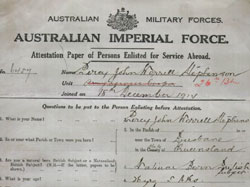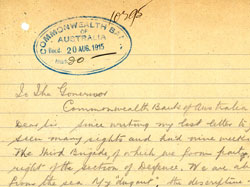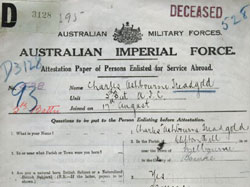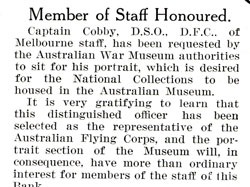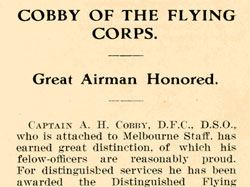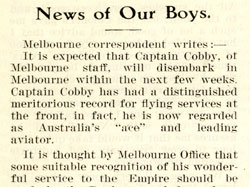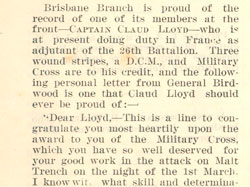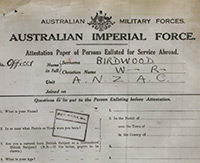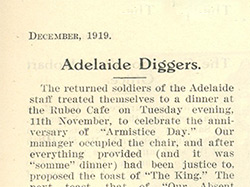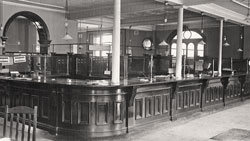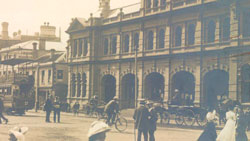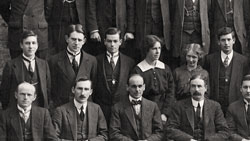From Bank to Battlefield
Staff Profiles
Corporal Walter Harry MacQueen, a bank clerk with the Commonwealth Bank's Head Office, was the first Sydney-based member of staff to enlist, signing up on 16 August 1914 (just days after the proclamation of war). By the end of the war, a total of 206 Commonwealth Bank officers had made the same decision to serve. Some of them didn't survive, others suffered injuries that could never be overcome while the lucky ones somehow picked up the pieces of their old lives after the hostilities were over. The mixed fate of these Bank staff who saw active service was a reflection of the war's brutality as well as an acknowledgement of their courage, tenacity and resourcefulness.
-
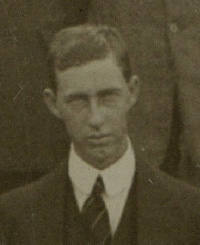
Ronald Grahame Henderson 22 years
Clerk -
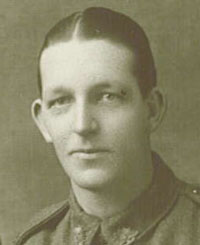
Percy William Bostock 23 years
Clerk -
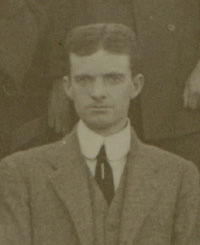
Leslie George Fussell 31 years
Clerk -
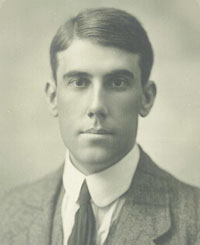
Percy John Worrell Stephenson 26 years
Clerk -
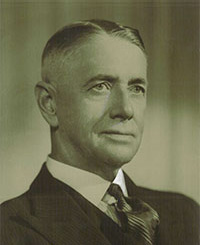
Louis Henry Morris 35 years
Manager -
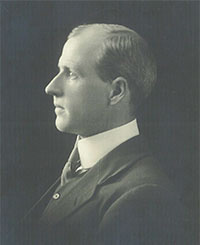
Lyndon Clifford Clinch 34 years
Clerk -

Arthur Oscar Rigg 24 years
Clerk -
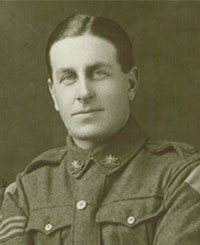
Reginald Clarence Owst Atkinson 24 years
Clerk -
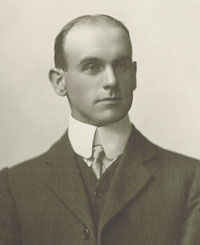
Ernest Hilmer Smith CB VD 36 years
Bank Superintendent -
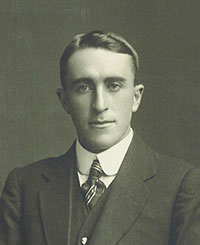
Vivian Cyril Brooke 27 years
Clerk -
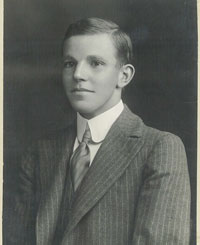
Charles Ashbourne Treadgold 22 years
Bank Clerk -
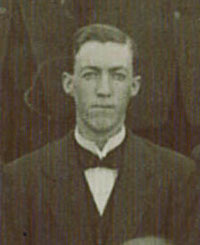
Roy Wood Croft 20 years
Clerk -
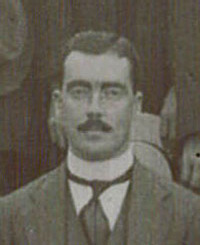
Roy Harrison 25 years
Bank Officer -

Herbert TC Layh 29 years
Bank Clerk -
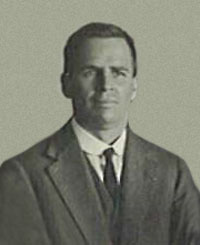
Walter Harry MacQueen 27 years
Bank Clerk -
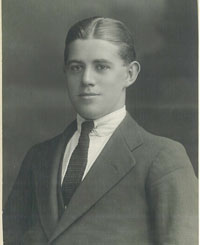
Norman Wilson 20 years
Bank Clerk -
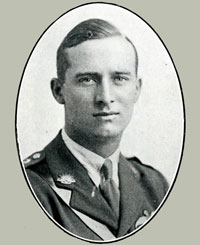
Arthur Henry Cobby 22 years
Bank Clerk -
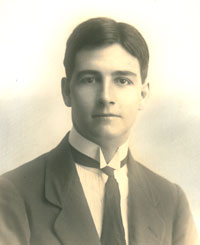
Francis Claud Lloyd 22 years
Clerk -
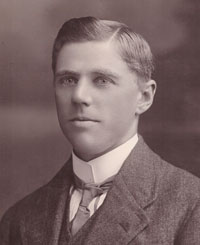
Robert Sabeston 32 years
Clerk -
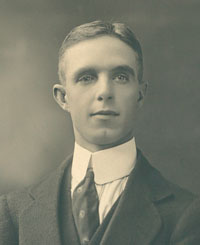
Percy Britten Wald 27 years
Accountant -
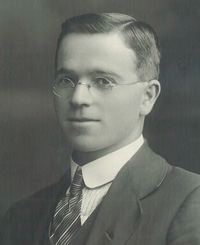
Oswald Langton Carlile 26 years
Clerk -
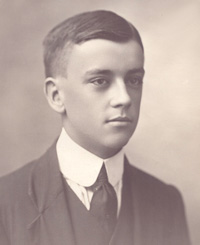
Roland Alaric Pryce Jackson 21 years
Clerk -
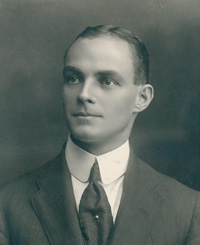
Arthur William Henry Stallwood 29 years
Clerk -
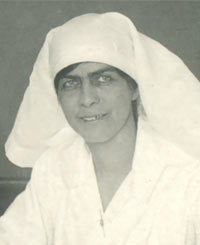
Elizabeth Ellen Murrell 37 years
Nurse -

Douglas Oswald Luke Kitto 19 years
Clerk -
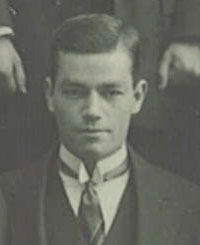
John Arthur Chambers 19 years
Clerk -

William Hermann Thummler 29 years
Clerk -
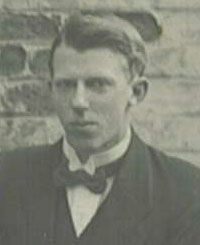
Cyril David McIntyre 20 years
Clerk
Ronald Grahame Henderson
Ronald Henderson was born in North Sydney to Stephen and Helen Henderson, and was the eldest of two sons. At 22 years old he was the first member of the Commonwealth Bank's Wagga Wagga Branch to enlist when he joined up on 17 April 1915. He spent the first six months of his military career training in Australia before he embarked for Egypt in October 1915, joining the 18th Infantry Battalion as part of the 5th Reinforcements.
Barely a month after joining his battalion in Egypt, Ronald was already displaying the bravery and determination that were to make him a respected and popular officer throughout his military career. By February 1916 he had earned a promotion to Corporal and two weeks later was embarking for France to join the fighting in the trenches of the Western Front.
Ronald entered the trenches near Armentieres at the end of April 1916, and remained there until June when he was wounded in the right thigh by a shell after being caught in a heavy artillery bombardment. He spent almost three months recovering in hospital in England before he was able to rejoin his battalion in France. His return to the front was only brief as, recognising his intrepid spirit and leadership qualities, he was promoted to Temporary Sergeant and sent to join the No.6 Officer Cadet battalion at Balliol in Oxford.
The training course Ronald attended in Oxford helped him to gain an appointment as 2nd Lieutenant upon his return to his battalion in March 1917. Two months later he was appointed Intelligence officer for the 5th Brigade and by June he had been made a Lieutenant. This swift advance up the ranks only solidified Ronald's daring and courageous character. During the Battle of Menin Road in September 1917, his fearless actions and dedication to duty earned him the Military Cross, which he was awarded on 1 January 1918. In the recommendation for this decoration he was commended for his “absolute disregard of personal safety” running the gauntlet of the constant and unrelenting shell fire to gain valuable information and bring back an accurate sketch of the front line.
In October, Ronald was badly injured for a second time in the mud-drenched battlefield of Poelcappelle in Belgium. During the fierce fighting he suffered gunshot wounds to both arms and his right hand which required a long convalescence in England. It was more than four months before Ronald was fully recovered, only being deemed medically fit to return to the front in February 1918.
While Ronald was demonstrating his bravery and endurance in the heavy fighting in Belgium, his younger brother, Hugh, enlisted in the 35th battalion in early July 1917, just two months after his 18th birthday. Tragically, Hugh never reached his 19th birthday. On 4 April 1918 he died of his wounds near Villers-Bretonneux less than two months after he had first arrived in France.
It is unlikely that Ronald ever knew about the death of his younger brother. Only five days after Hugh's death, Ronald was killed in an artillery bombardment near Villers-Bretonneux while extricating his platoon from their billets. It was only in death that the two brothers were reunited when, after peace had been declared, their bodies were re-interred side-by-side in the Adelaide Military Cemetery near Villers-Bretonneux. A photograph of the two gravestones marking their sons' final resting places in that distant field in France was their parents’ final memorial of their lost children.
| WWI Service Summary | 17 April 1915, enlisted in 18th Infantry Battalion, Australian Imperial Forces |
|---|---|
| 5 October 1915, embarked HMAT A32 Themistocles, Sydney | |
| 7 June 1916, wounded in action, | |
| 9 October 1917, wounded in action | |
| 1 January 1918, awarded Military Cross | |
| 9 April 1918, killed in action | |
| Rank | Lieutenant |
| Service Number | 2395 |
| Age at enlistment | 22 years |
| Role at Bank | Clerk |
Percy William Bostock
Percy Bostock was born in Fremantle, Western Australia, to Arthur and Alice Bostock. He worked as a clerk at the Commonwealth Bank in Perth and enlisted on 30 June 1916 at 23 years of age. Percy was initially assigned to the 10th Field Artillery Brigade 12th Reinforcements as a Gunner and was transferred to the 7th Field Artillery Brigade when he arrived in France in November 1917.
Percy spent the winter of 1917/18 in Flanders where his brigade engaged with the enemy at Armentieres and Ploegsteert. In late March 1918 the 7th Field Artillery Brigade was transferred to the Somme District, near Amiens, to strengthen the line against the German’s first attack of the Spring Offensive, Operation Michael. This was the brigade’s first experience of the more open conditions in the Somme Valley, and the men had to quickly adapt themselves to the new style of combat.
At the end of May 1918, the 7th Field Artillery Brigade moved to the Villers-Bretonneux Sector where it was involved in one of the most meticulously prepared and well-coordinated attacks of the war at Le Hamel. Planned by Lieutenant General John Monash, the Battle of Hamel on 4 July lasted just 93 minutes; it involved American and Australian infantry, British Mark V tanks, Australian artillery, and was where air drops of munitions and supplies to troops were pioneered on the battlefield. After this battle the advance continued and, aided by artillery barrages, the German front line was captured around Villers-Bretonneux and Monument Wood.
The 7th Artillery Brigade remained active for almost the entirety of the Hundred Days Offensive, which commenced in August 1918. However, Percy was absent from the Front for the first month due to illness, returning to his unit in early September. A month later he was engaged in the attacks around the St Quentin Canal where the Beaurevoir Line, the third and final defensive system of the Hindenburg Line, was broken. This was the last major action Percy would see before the end of the war.
When the Armistice was signed in November, the 7th Field Artillery Brigade was one of the few Australian units still in action on the Western Front. Percy remained in France until the end of 1918 when he was assigned to the Commonwealth Bank. He spent the first six months of 1919 working in both the London and Weymouth Offices before being reassigned to his unit to return to Australia.
Percy returned to Perth and was discharged in March 1920. He returned to work for the Commonwealth Bank, transferring to the Adelaide Branch in order to be nearer to his family.
| WWI Service Summary | 30 June 1916, enlisted |
|---|---|
| 11 May 1917, embarked HMAT A11 Ascanius, Melbourne | |
| 2 March 1920, discharged | |
| Rank | Gunner |
| Service Number | 34371 |
| Age at enlistment | 23 |
| Role at Bank | Clerk |
Leslie George Fussell
Born in Ballarat in 1883, Leslie Fussell was living in Sydney with his wife Ruby and employed at the Commonwealth Bank's Sydney Office when he enlisted on 7 May 1915. His previous military experience in the Melbourne Senior Cadet Battalion and the Victorian Rifles had earned him a commission as a Lieutenant, a position which he retained when he joined the 17th Infantry Battalion in 1915. Only 5 days after enlisting, Leslie boarded HMAT Themistocles headed for the Gallipoli Peninsula.
After a brief period of training in Egypt, the 17th Battalion arrived at Gallipoli in time to participate in the last major assault of the Gallipoli Campaign, the Battle of Hill 60. The following months were spent in a defensive capacity, mainly around Quinn's Post which was one of the most contested posts along the entire ANZAC front. By the time of the evacuation in December 1915, Leslie had proven himself to be a reliable and determined leader earning him a promotion to temporary Captain, a position that was made permanent in June 1916.
Leslie spent 1916 fighting in the trenches of France and Belgium. The first major action he faced on the Western Front was at Pozieres in July and August. With his permanent appointment as Captain only recently confirmed, Leslie successfully led his men through that terrible month with energy and determination.
His reliable leadership and cheerful attitude was recognised by his superiors who organised for him to be seconded to the 1st Anzac Corps School for further training for the first 6 months of 1917. In March, Leslie was recommended for the Military Cross for his “great keenness and devotion to duty”. This was awarded to him on 5 June before he received his promotion to major on 22 June. Leslie returned to his battalion was only back with them for 3 weeks before he was once again seconded as a brigade major trainee. He returned to his unit on 23 November 1917 and remained with them most of the following year.
After a second freezing winter, the 17th Battalion was stationed at the Front when the German Spring Offensive of 1918 was launched. During the months of this offensive the battalion was situated in the Somme Valley, holding back the German attacks. Then, in the summer of 1918 the Allied armies pushed forward against the Germans, and the 17th Battalion was in the midst of these attacks at Amiens, Mont St Quentin and Montbrehain. Leslie's determination and leadership through the final year of fighting, and his steady presence in the months that followed, earned him two mentions in despatches.
He remained in Europe through 1919 working on the demobilisation of the AIF, only receiving his decommission in January 1920. Leslie returned to Australia to work for the Commonwealth Bank taking up an appointment as manager of the Canberra branch in 1921. Leslie passed away in 1960 but the memory of this strong and determined officer and his service to his country has not been forgotten with Fussell Lane in Canberra now bearing his name.
| WWI Service Summary | 7 May 1915, enlisted in 17th Battalion, Australian Imperial forces |
|---|---|
| 12 May 1915, embarked HMAT Themistocles, Sydney | |
| 3 June 1917, awarded Military Cross | |
| 8 November 1918, mentioned in despatches | |
| 16 March 1919, mentioned in despatches | |
| 16 June 1920, decommissioned | |
| Rank | Major |
| Age at enlistment | 31 |
| Role at Bank | Clerk |
Percy John Warrell Stephenson
Percy Stephenson was a 26 year old clerk from the Commonwealth Bank's Brisbane Office. He had worked at the Commonwealth Bank since its inception, and was also one of the first members to work at the Brisbane branch when it opened in January 1913. Percy enlisted on 18 December 1914, and was initially assigned as a Driver for the Australian Army Service Corps, before embarking overseas in May 1915.
Serving in both Gallipoli and France, Percy's role throughout his military service was in combat support, first with the Service Corps and then as a member of the 26th Infantry Battalion. His dedication to duty saw him become Staff Quartermaster Sergeant in February 1917, before progressing through the ranks to become Lieutenant in January 1918. Percy was also attached to the London office of the Commonwealth Bank for six weeks from July 1917 to assist with the Australian war loan that was being floated in London.
It was after being attached to the Commonwealth Bank that Percy began to have a more active role in the fighting. Before returning to his unit in France he attended a course at the Lewis Gun School. His first opportunity to put these new skills into practice was in March 1918 when the 26th Battalion was stationed in Belgium as part of the defence against the German Spring Offensive.
Percy remained with the 26th Battalion through until the end of the war. Upon his return to Australia in 1919 he resumed work at the Commonwealth Bank, and in 1921 was appointed manager of the Charleville branch. He enjoyed a long and successful career at the Bank as manager in branches across regional Queensland. Percy retired in 1949.
| WWI Service Summary | 18 December 1914, enlisted |
|---|---|
| 24 May 1915, embarked HMAT A11 Ascanius, Brisbane | |
| 3 June 1919, discharged | |
| Rank | Lieutenant |
| Service Number | 6457 |
| Age at enlistment | 26 years |
| Role at Bank | Clerk |
Louis Henry Morris
Louis Morris enlisted in the 13th Light Horse Regiment on 20 March 1915 at the age of 35. This wasn't his first experience of war for he had begun his military career at the age of 19. From 1899 to 1902 he served with the South African Light Horse Regiment in the Boer War, for which he received the Queen's Medal with two bars and a promotion to Corporal.
Louis made the decision to once again enlist in the military 13 years later. In the intervening years he had progressed in his banking career to become manager of the Ballarat branch of the Commonwealth Bank and was happily married to his wife Ada. Prior to enlisting, Louis spent a month at the Officer School of Instruction in February 1915 before enrolling as a 2nd Lieutenant a month later.
Louis embarked from Melbourne with the 13th Light Horse in May 1915, bound for Egypt, where he spent the early months of 1916 and was involved in the defence of the Suez Canal. The 13th Light Horse was transferred to France in March 1916 where Louis faced the mud-filled fields of Western France. The static nature of trench warfare meant that mounted regiments could no longer perform their traditional reconnaissance role, instead he spent much of his time acting as support for the infantry divisions by carrying out traffic control, rear area security, and prisoner escorts.
One of the more active and mobile periods of fighting that Louis was involved in was in early 1918 during the German Spring Offensive. His regiment was transferred to Belgium at the beginning of March 1918, just before Germany launched Operation Michael, the first attack of the offensive. The 13th Light Horse was crucial in carrying out communication and reconnaissance missions as well as the evacuation of civilians in the face of heavy shelling and gas attacks.
Louis, now a Captain, was seconded to the Light Horse Training Deport in England in late April 1918. After helping to train members of the Light Horse at Tidworth Camp, Louis moved to the Commonwealth Bank to act as Manager at the Weymouth Branch in England, which had been set up for the convenience of the soldiers stationed in the area.
Louis was decommissioned in January 1920 and returned to his wife in Australia. The hard work and dedication that had seen him promoted to Captain during the war continued in his civilian life where he earned the position of Acting Inspector at the Commonwealth Bank of Australia.
| WWI Service Summary | 20 March 1915, enlisted in 13th Light Horse Regiment, Australian Imperial Forces |
|---|---|
| 28 May 1915, embarked on HMAT A34 Persic, Melbourne | |
| 21 January 1920, discharged | |
| Rank | Captain |
| Age at enlistment | 35 years |
| Role at Bank | Manager |
Lyndon Clifford Clinch
Lyndon Clinch was born in Urana, New South Wales, to John and Margaret Clinch. He worked at the Commercial Bank in Bourke before successfully applying for a job at the Commonwealth Bank's Sydney Office. In the winter of 1915, shortly after his 34th birthday, Lyndon married Elinor Hall at St Phillip's Church, Sydney, and the couple moved to Hunters Hill. It was eight months later that Lyndon decided to enlist in the infantry on 21 February 1916.
For the first year of his military life Lyndon remained in Australia serving in the Depot Battalions in Bathurst and Liverpool. In January 1917 he was transferred to the 7th Reinforcements for the 34th Battalion and embarked for the war in Europe. Arriving in France in September, Lyndon's first experiences of battle were in the shattered woods and muddy quagmires of Passchendaele. Here the men faced danger not only from the German artillery and machine guns, but also from the muddy bogs surrounding them which were capable of drowning the exhausted soldiers. By the time the 34th Battalion was relieved on 19 October 1917, casualties amounted to over 50 per cent of the battalion.
Over the winter of 1917/18, the battalion alternated periods of rest, training and service on the front line. Lyndon spent the early months of 1918 at the Australian Corp School in France returning to the front line to aid with the defence against the German Spring Offensive. He rejoined his unit near Villers-Bretonneux on 14 April 1918. Three days later, Lyndon was caught by a gas shell that was dropped by the Germans, and he was evacuated to a hospital in Rouen.
Lyndon did not return to the Front again, instead spending the remainder of the war at the Australian Corps School. He received his discharge in December 1919 and resumed his work at the Commonwealth Bank’s Sydney Office later that month.
| WWI Service Summary | 21 February 1916, enlisted in 34th Infantry Battalion |
|---|---|
| 24 January 1917, embarked HMAT A68 Anchises, Sydney | |
| 17 April 1918, wounded in action (gassed) | |
| 5 December 1919, discharged | |
| Rank | Private |
| Service Number | 3032 |
| Age at enlistment | 34 years |
| Role at Bank | Clerk |
Arthur Oscar Rigg
Born in Auckland, New Zealand, Arthur Rigg was living in Melbourne when he enlisted on 21 May 1915. After attending Melbourne Church of England Grammar School, Arthur chose to follow in his father's footsteps and enter a career in banking, successfully attaining a position as clerk in the Commonwealth Bank's Melbourne Office.
Arthur's commanding officers were quick to recognise his potential, and shortly after he enlisted he was sent to Officers Training School. He excelled in the courses that he undertook and received a promotion to 2nd Lieutenant before embarking overseas in January 1916. After arriving in England, Arthur joined the 5th Infantry Battalion. However, before joining his unit in the field, he was selected to attend the First Rifle Course at the School of Musketry in Tidworth.
Arriving in France in December 1916, Arthur joined the 5th Battalion in the Somme Valley where they were to spend their first freezing winter on the Western Front. Here, Arthur was able to put his training into practice and proved himself to be a dedicated and highly capable officer. By March 1917 he had earned a promotion to Lieutenant. For the next 12 months Arthur remained on the front pursuing the Germans as they retreated to the Hindenburg Lines, before he moved to Flanders to fight in the Third Battle of Ypres.
In January 1918, Arthur was appointed adjutant which placed him in charge of the organisation, administration and discipline of the battalion. He held this position throughout 1918 and carried out his duties with an unwavering dedication through the unrelenting attacks of the German Spring Offensive and subsequent Allied attacks of the Hundred Days Offensive. Arthur's actions during this period resulted in his promotion to Temporary Captain and caused his commanding officer to recommend him for the Military Cross, stating that Arthur had been “untiring in his efforts, both day and night, in making the operation a success, and it was due to his good work in the position of adjutant that these operations were successful”. This recommendation was not successful, but a second recommendation based on his actions in September 1918 resulted in Arthur being mentioned in despatches.
After peace was declared, Arthur travelled to Edinburgh where he married Mary Wingrove. They returned to Melbourne and Arthur resumed work at the Commonwealth Bank where he enjoyed a long and successful career.
| WWI Service Summary | 21 May 1915, enlisted |
|---|---|
| 28 January 1916, embarked HMAT A32 Themistocles | |
| 11 February 1920, discharged | |
| Rank | Captain |
| Service Number | 1003 |
| Age at enlistment | 24 |
| Role at Bank | Clerk |
Reginald Clarence Owst Atkinson
Reginald Atkinson was a 24 year old clerk at the Commonwealth Bank's Adelaide office when he enlisted on 6 September 1915. In January 1916 he was assigned to the 3rd Reinforcements for the 6th Field Artillery Brigade and left Australia bound for Egypt. While aboard HMAT Themistocles Reginald dropped a message in a bottle over the side. Less than a month later the bottle was found on a beach near Cape Leeuwin, the most south-westerly point of mainland Australia. The message inside read “Farewell Australia. All well and happy. Gnr R.C.O. Atkinson, Australian Field Artillery” and he requested that the note be forwarded to his mother.
Upon his arrival in Egypt, Reginald joined the newly formed 105th Howitzer Battery and was promoted to Bombardier. The Howitzer guns that he worked with were the largest artillery pieces used by Australians in land battles. Reginald's unit was transferred to France a month after its formation, and first saw action near Armentieres. In May 1916 the Australian artillery was reorganised and the 105th Howitzer Battery became part of the 5th Field Artillery Brigade.
Reginald remained with the 5th Field Artillery Brigade for the next two years, receiving a promotion to Corporal in July 1916, and then to Sergeant the following month. He was involved in the fighting at Passchendaele and Ypres in Belgium as well as at Villers-Bretonneux in France. In December 1918 Reginald was assigned to the Commonwealth Bank's temporary branch in Hurdcott Military Camp, England, working as a clerk.
Reginald was discharged in March 1920. He returned to Australia and resumed work at the Adelaide Office of the Commonwealth Bank.
| WWI Service Summary | 6 September 1915, enlisted |
|---|---|
| 28 January 1916, embarked HMAT A32 Themistocles, Melbourne | |
| 21 March 1920, discharged | |
| Rank | Sergeant |
| Service Number | 12171 |
| Age at enlistment | 24 |
| Role at Bank | Clerk |
Ernest Hilmer Smith CB VD
Ernest Hilmer Smith was 36 years old and Superintendent of the Commonwealth Bank's Hobart branch when he enlisted on 21 August 1914, the same day as his colleague Vivian Brooke.
Through luck, design or destiny, he was assigned initially as a Captain and ultimately as a Commanding Officer of the 12th Battalion, the very same Battalion that his Commonwealth Bank workmate Vivian Brooke had joined.
Reported to have led his company of the 12th ashore at Gallipoli on the morning of 25 April and up the ridge to what became known as ‘Bloody Angle’, as the enemy resistance stiffened, Smith sent his men to fill the gaps in the Anzac firing line that had formed almost 1 kilometre inland. In a letter home published in several Tasmanian newspapers, he described the ‘warm welcome’ they received from the enemy:
There was no time or opportunity for organising, we just had to climb up hills – something like those round the Cataract Gorge, only much steeper, and covered with prickly scrub, which tore our clothes and hands. Our casualties during the first hour were very heavy.
His correspondence from the front written to the Bank's Governor, Denison Miller, was not only poignant but at times poetic, humorous and heartbreaking. His letters provide a firsthand account of the realities of war and a unique insight into the warmth, humility and strength of character Lieutenant Colonel Smith possessed, along with a deep appreciation of the pastoral care afforded to the Bank's staff by the Governor.
Mentioned in dispatches which resulted in him being awarded the Companion of the Order of the Bath (CB), he remained with the 12th Battalion for most of the arduous months of the Gallipoli campaign before being transferred to the 11th Battalion and ultimately to 1st Commandant of the Australian Imperial Force training brigade. He saw further action in France and Belgium during 1916 and 1917 and suffered from chronic dysentery through most of his service.
Lieutenant Colonel Smith embarked for Australia from England in May 1918. He resumed his position with the Commonwealth Bank, being promoted to Superintendent of Victoria on his return and ultimately being appointed by the Governor as the Bank's Superintendent for New South Wales in 1925. Having survived the First World War and having personally battled several serious illnesses throughout his life, in a credit to his strength and tenacity, Ernest Hilmer Smith reached the age of 80, passing away in Sydney on 18 November 1958 from gangrene of the right foot and complications resulting from diabetes.
| WWI Service Summary | 24 August 1914, enlisted, Commanding Officer of 12th Battalion, Australian Imperial Forces |
|---|---|
| 20 October 1914, embarked HMAT Geelong A2, Hobart | |
| 8 November 1915, appointed as Companion of the Order of the Bath (date published in London Gazette) | |
| 18 August 1918, decommissioned from Australian Army | |
| Rank | Corporal |
| Age at enlistment | 36 years |
| Role at Bank | Superintendent |
Vivian Cyril Brooke
Vivian Cyril Brooke, a 27-year-old Commonwealth Bank clerk, from New Town in Hobart, Tasmania, was the son of Robert Parkinson and Sarah Amy Beaumont Brooke. He was well known in his hometown as an amateur athlete, footballer and cricketer and enlisted in the 12th Battalion of the Australian Imperial Force (AIF) on 20 August 1914. Brooke was among the first ashore at Gallipoli at 4.30 am on 25 April 1915.
It was reported in official AIF correspondence that he was in an advancing line of about 20 men in the region of Whites Gully on the day after the landing at Gallipoli. The enemy was making an attack on this group from the rear and a retreat was decided on, but Brooke refused to retire. He was wounded, captured and taken as a prisoner of war (POW) to Maidos (now Eceabat). A few days after his arrival he was injured further when the British Navy bombarded the town. The hospital was destroyed, killing many of the wounded soldiers held prisoner there. Brooke survived the shelling and was transferred with another Australian POW to the town of Bigha across the Dardanelles.
He died from his injuries and was buried in the Christian Cemetery at Bigha, Turkey. The last letter and postcard written to Brooke by his mother was returned to her as undelivered. It did not reach him before he was killed. Brooke's body was disinterred after the war, and he was buried just above the point where the first Australians came ashore on the Gallipoli Peninsula in 1915.
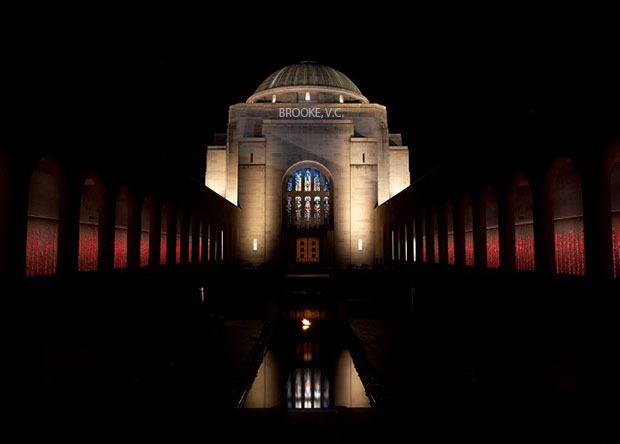
Source: Australian War Memorial.
VC Brooke's name projected on the Australian War Memorial building. See tab below for
projection timetable.
| WWI Service Summary | 20 August 1914, enlisted in 12th Battalion |
|---|---|
| 20 October 1914 embarked HMAT Geelong A2, Hobart | |
| 26 April 1915, wounded at Gallipoli, captured and taken prisoner at Maidos | |
| 4 May 1915 died of wounds whilst still Prisoner of War | |
| Service Number | 98 |
| Age at enlistment | 27 years |
| Role at Bank | Clerk |
- Final Resting Place
- Location on the Roll of Honour
- War Service Record
- Casualty Details
- Projection Timetable
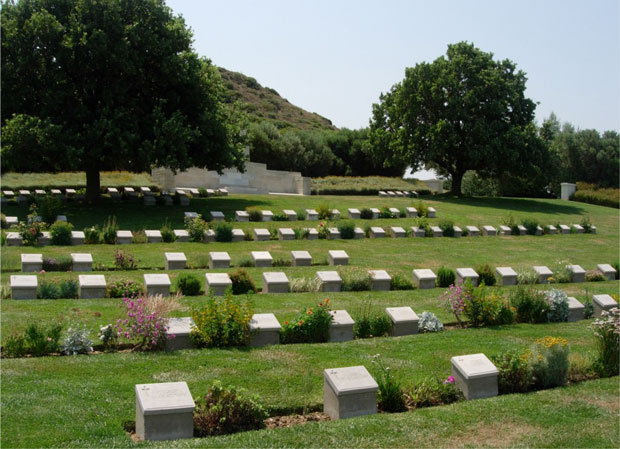
Cemetery:
Ari Burnu Cemetery, Anzac, Turkey
Grave Reference: G. 20.
Source: Commonwealth War Graves Commission
Vivian Cyril Brooke's name is located at panel 65 in the Commemorative Area at the Australian War Memorial
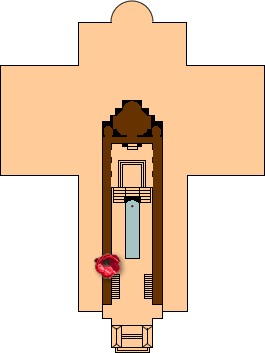
Source: Australian War Memorial
To obtain a Certificate with the Casualty Details go to Commonwealth War Graves Commission.
| Date and time | Name |
|---|---|
| Mon 11 May, 2015 at 12:23 am | Charles Ashbourne Treadgold |
| Tue 12 May, 2015 at 12:25 am | Roy Harrison |
| Wed 13 May, 2015 at 7:45 pm | Vivian Cyril Brooke |
| Mon 22 June, 2015 at 5:17 am | Charles Ashbourne Treadgold |
| Tue 23 June, 2015 at 4:53 am | Roy Harrison |
| Wed 24 June, 2015 at 10:51 pm | Vivian Cyril Brooke |
| Tue 4 August, 2015 at 1:02 am | Charles Ashbourne Treadgold |
| Wed 5 August, 2015 at 1:10 am | Roy Harrison |
| Thu 6 August, 2015 at 9:25 pm | Vivian Cyril Brooke |
| Mon 21 September, 2015 at 9:18 pm | Charles Ashbourne Treadgold |
| Tue 22 September, 2015 at 11:35 pm | Roy Harrison |
| Thu 24 September, 2015 at 10:55 pm | Vivian Cyril Brooke |
| Sat 16 January, 2016 at 11:41 pm | Charles Ashbourne Treadgold |
| Mon 18 January, 2016 at 3:49 am | Roy Harrison |
| Wed 20 January, 2016 at 10:54 pm | Vivian Cyril Brooke |
Charles Ashbourne Treadgold
Charles Ashbourne Treadgold, known as ‘Treaddy’, was a clerk with the Commonwealth Bank's Melbourne branch. Treadgold was the eldest son of Charles and Ellen Treadgold of Elsternwick, Victoria. At the age of 22 he lined up to enlist in the war, joining the 5th Battalion, one of the first infantry units raised for the Australian Imperial Force (AIF). Like the 6th, 7th and 8th Battalions, it was recruited from Victoria and together with these Battalions formed the 2nd Brigade.
Treadgold's battalion was among those that took part in the Anzac landing on 25 April 1915, acting as part of the second wave. The 2nd Brigade participated in the second battle of Krithia from 6–8 May 1915. This assault across open and relatively flat grassland was a failure and the enemy machine guns and artillery caused great losses in the British, French, New Zealand and Australian troops involved in the attack. Little ground was captured and the 2nd Brigade suffered 1,056 casualties in an hour, more than a third of its strength. The Brigade returned to the site of the Anzac landing to help defend the beachhead, participating in the battle of Lone Pine in August 1915.
The unit's war diary describes this experience: ‘Trenches in bad state as dead men all over the place and beginning to decompose, enemy bombing all night.’ Treadgold was promoted to Corporal in September 1915. Sadly, however, he died from a gunshot wound in the trenches in White Valley on 26 November, just a few weeks before the evacuation in December 1915. He left behind his widowed mother and his fiancée, Vera Kyd. Tragedy was to strike the Treadgold family a second time when his younger brother Newton was killed at the Battle of Bullecourt two years later, their mother Ellen losing both her sons in the Great War.
In 1919 staff at the Commonwealth Bank in Melbourne memorialised their dear friend and colleague Treaddy in the second edition of the staff magazine, Bank Notes:
He was an interesting and attractive personality – gay and happy, frank and engaging, vigorous and energetic, he was at once a favourite with all. As an old Wesley Collegian, he upheld the traditions of the school on the athletic side, and comradeship went hand in hand in his case. His death was greatly mourned by those who knew him, and he certainly was of the type that Australia could ill afford to lose.
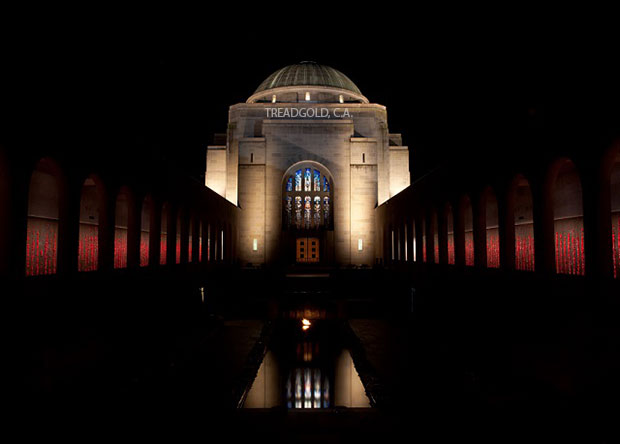
Source: Australian War Memorial.
CA Treadgold's name projected on the Australian War Memorial building. See tab below for
projection timetable.
| WWI Service Summary | 17 August 1914, enlisted in 5th Battalion, Australian Imperial Forces |
|---|---|
| 21 October 1914, embarked HMAT Orvietto A3, Melbourne | |
| 26 November 1915, wounded in action in Gallipoli Peninsula | |
| 27 November 1915, died from wounds | |
| Rank | Corporal |
| Service Number | 528 |
| Age at enlistment | 22 years |
| Role at Bank | Clerk |
- Final Resting Place
- Location on the Roll of Honour
- War Service Record
- In Memory of Treaddy
- Projection Timetable

Cemetery: Cemetery:
Ari Burnu Cemetery, Anzac, Turkey
Grave Reference:
G. 2.
Source: Commonwealth War Graves Commission
Charles Ashbourne Treadgold's name is located at panel 45 in the Commemorative Area at the Australian War Memorial (as indicated by the poppy on the plan).

Source: Australian War Memorial
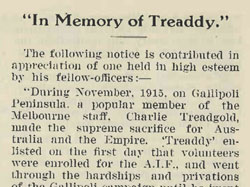
In Memory of Treaddy
The following notice is contributed in appreciation of one held in high esteem by his fellow-officers:
“During November, 1915, on Gallipoli Peninsula, a popular member of the Melbourne staff, Charlie Treadgold, made the supreme sacrifice for Australia and the Empire. ‘Treaddy’ enlisted on the first day that volunteers were enrolled for the A.I.F., and went through the hardships and privations of the Gallipoli campaign until he ‘went west’ a few weeks before the evacuation. He was an interesting and attractive personality – gay and happy, frank and engaging, vigorous and energetic, he was at once a favourite with all. As an old Wesley Collegian (Melbourne), he upheld the traditions of the school on the athletic side, with which the sportsmanlike attributes of fairness, generosity and comradeship went hand in hand in his case. His death was greatly mourned by those who knew him, and he certainly was of the type that Australia could ill afford to lose.”
Source: Bank Notes magazine – January 1919, page 6
| Date and time | Name |
|---|---|
| Mon 11 May, 2015 at 12:23 am | Charles Ashbourne Treadgold |
| Tue 12 May, 2015 at 12:25 am | Roy Harrison |
| Wed 13 May, 2015 at 7:45 pm | Vivian Cyril Brooke |
| Mon 22 June, 2015 at 5:17 am | Charles Ashbourne Treadgold |
| Tue 23 June, 2015 at 4:53 am | Roy Harrison |
| Wed 24 June, 2015 at 10:51 pm | Vivian Cyril Brooke |
| Tue 4 August, 2015 at 1:02 am | Charles Ashbourne Treadgold |
| Wed 5 August, 2015 at 1:10 am | Roy Harrison |
| Thu 6 August, 2015 at 9:25 pm | Vivian Cyril Brooke |
| Mon 21 September, 2015 at 9:18 pm | Charles Ashbourne Treadgold |
| Tue 22 September, 2015 at 11:35 pm | Roy Harrison |
| Thu 24 September, 2015 at 10:55 pm | Vivian Cyril Brooke |
| Sat 16 January, 2016 at 11:41 pm | Charles Ashbourne Treadgold |
| Mon 18 January, 2016 at 3:49 am | Roy Harrison |
| Wed 20 January, 2016 at 10:54 pm | Vivian Cyril Brooke |
Roy Wood Croft
Roy Wood Croft, the son of Hannah and Eugene Croft of ‘Leddicott’, Darlinghurst, was a
20-year-old clerk from the Commonwealth Bank's Sydney office. Educated at King's College,
Goulburn, he was well known in the district where he competed in many equestrian events throughout
his youth. It was these horsemanship skills combined with his previous training in the military
which saw him quickly assigned to the 1st Australian Light Horse on 22 August 1914 as the regiment's
trumpeter.* Although the role of trumpeter was normally held by a more senior officer, and a more
junior officer was assigned as the regimental ‘bugler’, young Croft already had a few
years' experience as a trumpeter for the 11th (Australian Horse) Light Horse, which he had
joined in Sydney in 1912.
The trumpeter was usually responsible for sounding the charge into battle, an important role which
often made them an obvious target of the enemy. The 1st Light Horse Regiment landed at Gallipoli on
12 May 1915 and was attached to the New Zealand and Australian Division. It played a defensive role
for most of the campaign but mounted an attack on the Turkish position known as ‘the
Chessboard’ as part of the August 1915 offensive.
On 7 August, 200 men of the 1st Light Horse were involved in this assault, 147 of them becoming casualties, including Croft. Describing this experience in a letter to his mother on 14 August from the Gherireh Palace Hospital, he found it very difficult to put it down on paper as it would not seem half so realistic. Stating that he had never seen a dead body before, within minutes of launching the attack he recounted how awful it was to watch all his chums being cut down around him. Croft was hit in the leg by shrapnel from a grenade and was only saved from it being blown completely off by his water bottle. He was also protected from certain death by a tin of bully beef, which prevented a bullet from entering his spine. Although his letter implores his mother not to worry and indicates that, remarkably, he was neither scared nor excited during battle, it shows a clear sense of his understanding of the gravity of the situation.
It was his opinion that anyone belonging to the Light Horse was lucky to be alive, believing they were sent to certain death on the battlefield. After returning to Australia, Croft studied medicine, developed successful practices in both Kings Cross and Balmain, and married Elma Pringle. He passed away in 1978 at the age of 84.
⃰ Each Regiment of the Light Horse had a ‘trumpeter sergeant’ equipped with a cavalry trumpet and a ‘bugler’ of lower rank equipped with a bugle. Technically called a cavalry trumpet, the instrument was in effect a longer version of the bugle, as it did not have the valves of a true band or orchestral trumpet. The trumpet and bugle sounded in different keys. Both were carried slung over the rider's body by means of green tasselled cords.
| WWI Service Summary | 22 August 1914, enlisted in 1st Light Horse Regiment, Australian Imperial Forces |
|---|---|
| 20 October 1914, embarked HMAT Star of Victoria A16, Sydney | |
| 7 August 1915, wounded at ‘The Nek’, Gallipoli | |
| 4 September 1915, invalided to Australia | |
| 21 January 1916, medically discharged from Australian Army | |
| Service Number | 290 |
| Rank | Private |
| Age at enlistment | 20 years |
| Role at Bank | Clerk |
Roy Harrison
Born in Yass in 1889 and educated at the Goulburn district school, Roy Harrison was employed at the Commonwealth Bank’s Head Office in Sydney. Although he had been at the Bank for only six months when he enlisted, he was described on his Bank staff card as a ‘first-class man, particularly reliable and competent in his role as an examiner with the Savings Bank Department’. He dropped rank to Second Lieutenant to join the 2nd Australian Infantry Battalion, having risen to the rank of Lieutenant in his previous military service with the Scottish Rifle and Woollahra Infantry Regiments from 1908 to 1914.
On 25 April 1915 he landed at Gallipoli and was the only original officer from the 2nd Battalion to stay for the whole of the campaign. Following the evacuation, he was promoted to Major. Roy wrote regularly to his fiancée, Emily Ellis, during the war and his last letter to her a few days before he, along with 5,532 other Australian soldiers were either killed, wounded or captured in a single night at Fromelles in France, was particularly poignant: ‘By the time this reaches you, the result will be known to you through the paper so failing any bad news, you may take it that all is well.’ Although previous correspondence to Emily from the heat of battle at Gallipoli did not have such a stoic tone, he appears to have an almost ethereal knowledge of what his fate in France would be, writing:
It is no use worrying as I am quite satisfied that what is to be, will be, and nothing can alter it for good or evil … The men don’t know yet what is before them, but some suspect that there is something in the wind. It is a most pitiful thing to see them all, going about, happy and ignorant of the fact, that a matter of hours will see many of them dead; but as the French say “Cest la guerre”.
Four days later, Roy was reported as missing. He was eventually listed as being killed in action, although his body was never found during the war. In 1921 the remains of an officer were discovered in a field in France and exhumed by the Imperial War Graves Commission. Within the pocket of the officer’s uniform was a small silver cigarette case bearing the inscription, To Lieut. Harrison from Jeff & Sum 16/9/1914.
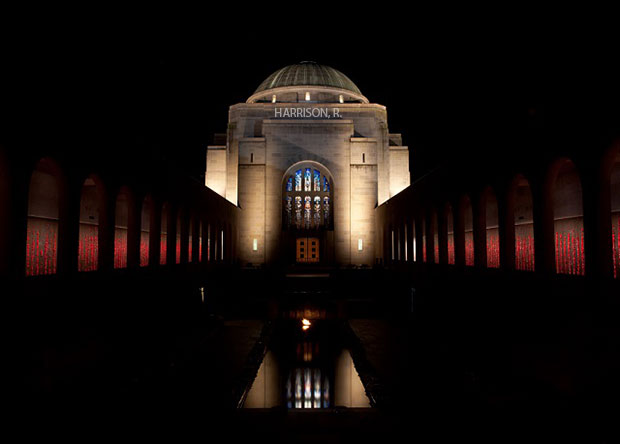
Source: Australian War Memorial.
R Harrison's name projected on the Australian War Memorial building. See tab below for
projection timetable.
| WWI Service Summary | 17 August 1914, enlisted in 2nd Battalion, Australian Imperial Forces |
|---|---|
| 18 October 1914, embarked HMAT Suffolk A23, Sydney | |
| 20 July 1916, killed in action in Fromelles from shell fire | |
| Buried at Rue-Petillon Military Cemetery, Fleurbaix, France | |
| Rank | Major |
| Service Number | Z349 |
| Age at enlistment | 25 years |
| Role at Bank | Officer |
- Final Resting Place
- Location on the Roll of Honour
- War Service Record
- Casualty Details
- Projection Timetable
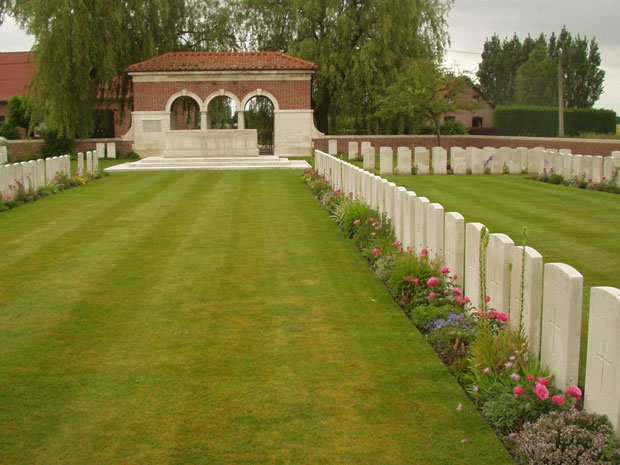
Cemetery: Rue-Petillon Military Cemetery, Fleurbaix, France
Grave Reference:
I.D. 20.
Source: Commonwealth War Graves Commission
Roy Harrison's name is located at panel 159 in the Commemorative Area at the Australian War Memorial (as indicated by the poppy on the plan).

Source: Australian War Memorial
To obtain a Certificate with the Casualty Details go to Commonwealth War Graves Commission.
| Date and time | Name |
|---|---|
| Mon 11 May, 2015 at 12:23 am | Charles Ashbourne Treadgold |
| Tue 12 May, 2015 at 12:25 am | Roy Harrison |
| Wed 13 May, 2015 at 7:45 pm | Vivian Cyril Brooke |
| Mon 22 June, 2015 at 5:17 am | Charles Ashbourne Treadgold |
| Tue 23 June, 2015 at 4:53 am | Roy Harrison |
| Wed 24 June, 2015 at 10:51 pm | Vivian Cyril Brooke |
| Tue 4 August, 2015 at 1:02 am | Charles Ashbourne Treadgold |
| Wed 5 August, 2015 at 1:10 am | Roy Harrison |
| Thu 6 August, 2015 at 9:25 pm | Vivian Cyril Brooke |
| Mon 21 September, 2015 at 9:18 pm | Charles Ashbourne Treadgold |
| Tue 22 September, 2015 at 11:35 pm | Roy Harrison |
| Thu 24 September, 2015 at 10:55 pm | Vivian Cyril Brooke |
| Sat 16 January, 2016 at 11:41 pm | Charles Ashbourne Treadgold |
| Mon 18 January, 2016 at 3:49 am | Roy Harrison |
| Wed 20 January, 2016 at 10:54 pm | Vivian Cyril Brooke |
Herbert Thomas Christopher Layh
Herbert Thomas Christopher Layh was born on 3 April 1885 in Hamilton, Victoria, the son of German-born Carl Layh, an accountant, and his English wife, Jane Emma Remfry. In September 1900 at the age of 15 he was employed as a clerk with the Savings Bank in Hamilton, which was later taken over by the State Savings Bank of Victoria. Transferred to Melbourne in 1906, he completed his senior examinations at the Bankers Institute. In 1908 he married Beatrice Olive Akeroyd and had a son and a daughter. He resigned from his position with the State Savings Bank to join the newly founded Commonwealth Bank of Australia in July 1912 as a clerk in the Bank's Melbourne branch.
Layh had an active interest in military training in the civilian forces and by July 1913 had become militia adjutant of the 60th (Prince's Hill) Infantry. When war was declared, Layh was released from his position at the Bank and enlisted on 14 August 1914. Appointed as Lieutenant and assigned to the 7th Battalion under soldier, lawyer and politician HE ‘Pompey’ Elliott, Layh embarked for Egypt two months later and was promoted to Captain. Layh's Battalion took part in the Gallipoli landing on 25 April 1915. His boat was one of four that mistakenly beached in front of the Turkish positions at Fisherman's Hut on North Beach. He described the approach to the beach in a letter to his family, which was published in The Argus on 9 July 1915:
We could hear the firing going on, and the shells from the Turks’ guns fell very close to us. As there was no tow for us, the Colonel decided that we were to row ashore in the boats. I was in the first lot of boats, and we started gaily for the shore. As we drew near we could see that the water was being churned up by the bullets, and that we were in for a hot time. The rowers pulled hard, and we entered the beaten zone at a good pace. The bullets zipped around us like bees. Before the keel grated on the beach five or six of the rowers were shot, together with many others. As a matter of fact, only 10 out of 30 left the boats, the rest being either dead or wounded. As I was climbing out of the boat a bullet hit me in the left buttock. We sprinted across the beach and took cover behind some small sand heaps, leaving some more lying on the beach.
It was reported that he served with conspicuous courage and zeal during the landing at Gallipoli. He was awarded the Distinguished Service Order for his excellent service at Lone Pine and during the evacuation, and after being transferred was also credited with being the mainstay of the new 59th Battalion owing to his knowledge and ability. Transferred again to the 57th Battalion, he commanded it in the 2nd battle of Villers-Bretonneux before being transferred to command the 60th Battalion.
In January 1919 he resumed duty with the Commonwealth Bank's Melbourne branch, where he continued to work for a further five years, eventually resigning from service on 30 June 1924. After the death of his wife in 1934, he remarried four years later to widow Olive Blanche Turner, who subsequently predeceased him. Having survived the ravages of the First World War, sadly and tragically on 10 April 1964 at the age of 79, Layh was killed after being struck by a car in Box Hill.
* An adjutant is a staff officer in charge of the organisation, administration and discipline of a battalion or regiment.
| WWI Service Summary | 24 August 1914, enlisted in 7th Battalion, Australian Imperial Forces |
|---|---|
| 19 October 1914, embarked HMAT Hororata A20, Melbourne | |
| 1 May 1915, wounded in Gallipoli | |
| 1 January 1917, awarded Distinguished Service Order (date published in London Gazette) | |
| 11 May 1917, wounded in action (gas shell) | |
| 7 June 1918, awarded Bar to Distinguished Service Order | |
| 1 January 1919, appointed as a Companion of the Order of St Michael and St George | |
| 24 January 1919, decommissioned from Australian Army | |
| Rank | Lieutenant Colonel |
| Age at enlistment | 29 years |
| Role at Bank | Officer |
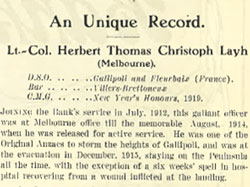
An Unique Record
Lt.-Col. Herbert Thomas Christoph Layh
(Melbourne).
D.S.O. Gallipoli and Fleurbaix (France).
Bar Villers-Brettoneux
C.M.G. New Year's Honours, 1919
Joining the Bank's service in July, 1912, this gallant officer was at Melbourne office till the memorable August, 1914, when he was released for active service. He was one of the Original Anzacs to storm the heights of Gallipoli, and was at the evacuation in December, 1913, staying on the peninsula all the time, with the exception of a six weeks’ spell in hospital recovering from a wound inflicted at the landing.
In June, 1916, Lieut.-Colonel Layh left with the 5th Division for France, and the following month commanded the 59th Battalion at Fleurbaix, continuing to do so until May the following year, when he was gassed at Bullecourt.
He was next placed in charge of a Training battalion at Codford whilst recuperating in England.
In March, 1918, he was recalled to France, and given command of the 57th and 60th Battalions. In this period he took part in engagements at Villers-Brettoneux and Hamel, and various other “stunts” where Australia won imperishable fame during the terrific German “drive” towards Amieus and the subsequent big Allied advance which followed in August. It was at the first-named village that he added the Bar to the D.S.O., which was gallantly won leading his men at Fleurbaix.
Returning to Australia on furlough with the Original Anzacs in November, 1915 Bank officers learned with great pleasure that one of their most distinguished fellow-workers had been listed among those to receive New Year honours.
Source: Bank Notes magazine – February 1919, page 2
Walter Harry MacQueen
Walter Harry MacQueen was the son of Archibald and Sophia MacQueen of Neutral Bay, Sydney. He was employed as a bank clerk with the Commonwealth Bank's Head Office in November 1913 after previous service with both the Government Savings Bank of New South Wales and the Bank of Australasia.
In 1914 he was the first Sydney-based officer of the Bank to serve, joining E Company of the Australian Naval and Military Expeditionary Force (ANMEF) on 16 August. He was posted as a corporal and three days after enlisting embarked aboard the transport ship HMAT Berrima on 19 August 1914. After a period of training near Townsville, he sailed for Port Moresby to await the arrival of supporting Royal Australian Navy vessels HMAS Sydney, Parramatta, Yarra and Warrego and Australia's first Submarines, HMAS AE1 and AE2.
He took part in the New Britain engagement in Rabaul, the capital of German New Guinea, which was occupied by troops from the ANMEF from September 1914 to the end of the war. He returned to duty with the Bank in 1915 and in 1916 married Francis Price. In 1917 he was transferred to Townsville, then to Hobart, where he served as the Manager of the War Loan Department.
After returning to Sydney he was appointed as an officer in charge of both the George Street and William Street branches and also served as the honorary treasurer of the Australian Mothercraft Society. In 1932 he was appointed Manager of the Taylor Square branch of the Commonwealth Bank, where he remained until his retirement in 1951.
| WWI Service Summary | 16 August 1914, enlisted, E Company, Australian Naval and Military Expeditionary Force (ANMEF) |
|---|---|
| 19 August 1914, embarked HMAT Berrima A35, Sydney | |
| 4 March 1915, discharged from service | |
| Rank | Corporal |
| Service Number | 442 |
| Age at enlistment | 27 years |
| Role at Bank | Clerk |
Norman Wilson
Norman Wilson was a 20-year-old clerk at the Melbourne office of the Commonwealth Bank when he enlisted. He had gained prior military experience having spent 12 months training in the Public School cadets.
He served in the 14th Battalion, which along with the 13th, 15th and 16th Battalions formed the 4th Brigade commanded by Colonel John Monash.
Norman was awarded a Military Cross for conspicuous bravery near Harcourt after it was reported he led his company with great dash and skill, keeping his command under splendid control though hampered first by dense fog and later by considerable enemy fire. Though the troops on his left side were held up he fought on with the aid of the only tank left standing and carried the village, captured many machine guns and over 200 prisoners. He then pushed on further and took practically the whole Battalion frontage on the Red line, enabling the Battalion following to leap-frog through.
He sent back valuable information throughout and the success of his company was largely due to his personal energy and daring, which it was said, provided a splendid example to all ranks.
| Service Summary | 18 September 1914, enlisted in 14th Battalion, Australian Imperial Forces |
|---|---|
| 22 December 1914, embarked HMAT Ulysses A38, Melbourne | |
| 14 February 1918, wounded (gassed, mild), admitted to St John’s Ambulance Hospital | |
| 16 September 1918, awarded Military Cross for conspicuous bravery near Harcourt on 8 August 1918 | |
| 6 October 1919, discharged from service | |
| Rank | Captain |
| Service Number | 149 |
| Age at enlistment | 20 years |
| Role at Bank | Clerk |
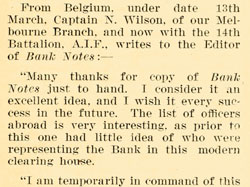
From Belgium, under date 13th March. Captain N. Wilson of our Melbourne Branch and now with the 14th Battalion, A.I.F., writes to the Editor of Bank Notes:
“Many thanks for copy of Bank Notes just to hand. I consider it an excellent idea, and I wish it every success in the future. The list of officers abroad is very interesting, as prior to this one had little idea of who were representing the Bank in this modern clearing house.
“I am temporarily in command of this battalion, but hope to be relieved shortly and to start on a grand tour, including Paris, Nice, Monte Carlo, Venice, Florence, Rome and Brussels.
“Here's one for your magazine, and actually happened too! At a recent sale of Australian horses and mules in this village, a Belgian auctioneer regarding a poor specimen of a mule, loudly shouted, ‘Un mille franc pour un grand moule!’ A digger, hearing this, and knowing the mule well, was heard to exclaim, ‘ ’Streuth! A million francs for a … old mule like that!’
“I don’t expect to get back to Melbourne till about September.”
Source: Bank Notes magazine – May 1919, page 8
Arthur Henry Cobby CBE
Arthur Henry Cobby, who went by the name of Harry, was a highly decorated Australian fighter pilot, who was born at Prahan in Victoria on 26 August 1894. He was the son of Arthur Cobby snr and Alice Cobby (nee Nash) and was one of four brothers.
Harry Cobby was employed as a bank clerk at the Melbourne office of the Commonwealth Bank of Australia when war was declared in 1914. Two years earlier, at just 18, he had gained a commission in the Army with the 47th Infantry, but had not yet embarked on a full military career.
In 1916, at the age of 22, he joined the Australian Imperial Force (AIF) and, despite having little prior knowledge or experience of flying, was posted to the Central Flying School, Australian Flying Corps (AFC) at Point Cook, Victoria. Cobby completed his initial training there in December 1916 and graduated as a 2nd Lieutenant, No.4 Squadron.
In January 1917 he departed Australia with his Squadron, arriving in Plymouth, England, in March that same year. Nine months later, after further training, he was flying fighter planes, including the famous Sopwith Camel, over the battlefields of France. His courage and abilities were soon noted and it was not long before he was regarded as one of the most capable and daring of the Australian airmen. Cobby was credited with the downing of 29 aircraft and 13 balloons; the highest number attributed to any Australian during the First World War. His exploits earned him the Distinguished Flying Cross, later with two bars, the Distinguished Service Order and mention in dispatches. The citations accompanying these awards praised his gallantry, courage, brilliant flying ability, clear judgment, presence of mind, determination, skill and success as a leader.
Cobby’s exploits were widely reported back home in Australia. At the Commonwealth Bank, reports of his courage and flying prowess were greeted with immense pride. Cobby, in writing to the Bank’s staff magazine Bank Notes towards the end of the war, was more philosophical about his successes. He was, he wrote, ‘more to be congratulated on being alive than doing anything special, as the whole AFC strive after good results, and of course some go west, and those that live reap the benefits of the whole’.
Harry Cobby returned to Australia in May 1919 as a household name. He became the representative of the AFC and a portrait of him, by William McInnes, was commissioned for the Australian War Museum. The Commonwealth Bank, in recognition of his distinguished war service, sent letters of welcome to him from each of its state branches. The Bank noted that his great successes were not unexpected ‘for we were all well aware that his temperament and courage eminently fitted him for distinction as a daring and successful aviator’.
In 1921 Cobby joined the Australian Air Force as a full-time flying officer, before eventually rising to the rank of Wing Commander. He fought with the Royal Australian Air Force (RAAF) during the Second World War, and was awarded the George Medal and appointed Commander of the Order of the British Empire. After the war he held several distinguished posts, including with the Department of Civil Aviation.
In 1920 Harry Cobby had married Hilda Maude Urban. The couple had one son and one daughter. He died in Melbourne in November 1955, still a national hero, and was accorded full military honours at his funeral.
| WWI Service Summary | 23 December 1916, enlisted in 4th Squadron, Australian Flying Corps, Australian Imperial Forces |
|---|---|
| 17 January 1917, embarked HMAT Omrah, Melbourne | |
| 14 May 1918, awarded Distinguished Flying Cross | |
| 3 August 1918, awarded bar to Distinguished Flying Cross | |
| 21 September 1918, awarded bar to Distinguished Flying Cross | |
| 8 November 1918, awarded Distinguished Service Order | |
| 24 July 1919, decommissioned from service | |
| Rank | Captain |
| Age at enlistment | 22 years |
| Role at Bank | Clerk |
Member of Staff Honoured
Captain Cobby, D.S.O., D.F.C., of Melbourne staff, has been requested by the Australian War
Museum authorities to sit for his portrait, which is desired for the National Collections to
be housed in the Australian Museum.
It is very gratifying to learn that this distinguished officer has been selected as the
representative of the Australian Flying Corps, and the portrait section of the Museum will,
in consequence, have more than ordinary interest for members of the staff of this Bank.
COBBY OF THE FLYING CORPS.
Great Airman Honored.
CAPTAIN A. H. Cobby, D.F.C., D.S.O., who is attached to Melbourne Staff, has earned great distinction, of which his felow[sic]-officers are reasonably proud. For distinguished services he has been awarded the Distinguished Flying Cross (a new decoration for airmen) with two bars, and word recently came through that the D.S.O. has also been bestowed on him. He enjoys the distinction of having brought down considerably more Hun planes than any other pilot of the A.F.C., so we shall not be surprised to learn of any new honour having been given him. To have led an enormous squadron of British and American airmen in an attack on the German aerodromes at Haubourdin is no mean achievement. In eleven days he bagged five enemy “birds”. One evening he, with another machine, attacked five enemy planes, downing three of them. He had accounted for twenty-one machines and balloons when we last heard. His great successes are not unexpected, for we were all well aware that his temperament and courage eminently fitted him for distinction as a daring and successful aviator.
News of Our Boys.
Melbourne correspondent writes: It is expected that Captain Cobby, of Melbourne staff, will disembark in Melbourne within the next few weeks. Captain Cobby has had a distinguished meritorious record for flying services at the front, in fact, he is now regarded as Australia’s “ace” and leading aviator.
It is thought by Melbourne Office that some suitable recognition of his wonderful service to the Empire should be made by the Bank as a whole, and we would suggest that each capital branch forward a letter of welcome to him care of Melbourne Office and Melbourne will do the rest.
Mr. Jas. White writes a long interesting letter to Mr. H. T. Armitage from Moascar under date 4th April, mentioning amongst other things the native uprisings have assumed such proportions as to retard demobilisation of our Palestine Army somewhat.
Gunner V. H. Woodward (Perth), writing from Belgium, under date 15th March, expresses good wishes to all old friends, and his gratitude at receipt of his Christmas bonus.
R.Q.M. Sergeant G. L. Bingham, of Perth also, writing from London, expresses his thanks for receipt of the bonus, and the earnest hope that he will be with us before the end of the year.
Perth branch is pleased to have back again Private E. J. Bray, who after nearly three months’ convalescence from his severe attack of Spanish influenza, has now quite recovered.
Mr. G. H. Ford, who left Perth Staff in May, 1915, to join the A.I.F., has now returned. He left Western Australia in June, 1915, with the 28th Battalion, went through the Gallipoli campaign; was at London Office, and with the 8th Battery in the big push, finishing up at Brussels. He has now returned after his four years’ service, and rejoined the staff.
News comes through of Driver A. Stewart, the genial Head Office man with the infectious grin, who used to handle infuriated crowds at the cable counter, with so much tact and good humour, in the “off” seasons, when cables were slower than mail boats. When last seen by Mr. B. C. Cannon, of our Tidsworth Branch, he was a burly driver in the overworked A.S.C., all unshaven and unshorn. In fact, when first sighted, there were unworthy suspicions of bushrangers, Bolsheviks, etc., but a closer acquaintance revealed the old Alex., of the comfortable embonpoint! Source: Bank Notes magazine – June 1919
Please email us if you are a relative or have further information that you would like to share.
Captain Francis Claud Lloyd
Francis Claud Lloyd was born in Roma, Queensland, and worked as a clerk at the Commonwealth Bank in Brisbane. He was 22 years old when he enlisted in the 26th Infantry Battalion of the Australian Imperial Force (AIF) on 29 April 1915. Lloyd stayed with the 26th Battalion throughout his service and was at Gallipoli, then in France and Belgium, fighting in many of the major battles in which the AIF was involved between 1916 and 1918.
While holding the position of adjutant,* Lloyd rose through the ranks from Sergeant to Captain and had a distinguished record of service. He was awarded the Distinguished Conduct Medal in September 1916 for his service during the attacks at Pozières ridge. Despite being wounded in both legs and in the head, he remained on duty organising the men into the correct formation and seeing his wave safely off before receiving medical attention.
The following year, in March 1917, Lloyd also received the Military Cross for the ‘tactical ability, skill and dash’ he showed during the attack on Malt Trench, north of Warlencourt, France, in which he not only captured enemy trenches but also repelled the enemy counterattack. Lloyd was recognised once more in February 1918 when he was mentioned in despatches and also received a personal letter from General Birdwood congratulating him for the awards that he had received.
Wounded twice more after the attack on Pozières ridge – the second time in March 1917 in action near Lagnicourt in northern France – he once again remained on duty despite his injuries. The third time Lloyd was wounded was during his Battalion's last action on 3 October 1918. The Battalion was part of the operation to breach the Beaurevoir Line, the third and final line of the Hindenburg defences. Lloyd suffered severe gunshot wounds to the neck, abdomen and left thigh and was invalided back to England where he spent the next few months recovering.
Lloyd was discharged from service on 25 November 1919. He returned to Australia and resumed his post at the Commonwealth Bank, remaining in banking throughout his career.
* An adjutant is a staff officer in charge of the organisation, administration and discipline of a battalion or regiment.
| WWI Service Summary | 29 April 1915, enlisted in 26th Infantry Battalion, Australian Imperial Forces |
|---|---|
| 24 May 1915, embarked HMAT Ascanius A11, Brisbane | |
| 2 September 1916, awarded Distinguished Conduct Medal | |
| 19 November 1916, wounded in action near Flers, remained on duty | |
| 29 March 1917, wounded in action near Lagnicourt, remained on duty | |
| 31 March 1917, awarded Military Cross | |
| 27 February 1918, mentioned in despatches | |
| 3 October 1918, wounded in action near Grandcourt (GSW neck, abdomen, left thigh, severe) | |
| 25 November 1919, discharged from service | |
| Rank | Captain |
| Service Number | 221 |
| Age at enlistment | 22 years |
| Role at Bank | Clerk |
- War Service Record
- Bank Notes Magazine Article
- General Birdwood Biography
- General Birdwood War Service Record
Brisbane Branch is proud of the record of one of its members at the front – CAPTAIN CLAUD LLOYD – who is at present doing duty in France as adjutant of the 26th Battalion. Three wound stripes, a D.C.M., and Military Cross are to his credit, and the following personal letter from General Birdwood is one that Claud Lloyd should ever be proud of:–
“Dear Lloyd, – This is a line to congratulate you most heartily upon the award to you of the Military Cross, which you have so well deserved for your good work in the attack on Malt Trench on the night of the 1st March. I know with what skill and determination you wiped out the opposition in the enemy trenches, and, immediately on gaining your objective, how successfully you arranged the disposition of your posts in front of the position, thus enabling you to repel an enemy counter-attack with heavy loss. Thank you so much for this, and wishing you all good fortune in the future.
Yours sincerely, (Sgd.) W.R. Birdwood”
Source: Bank Notes magazine – December 1918, page 6
General Sir William Birdwood
General Birdwood (1865–1951) was born in Bombay and educated in England. He began his military service in India in 1885 and was steadily promoted, becoming a senior officer in Britain's Indian Army. When the First World War began, Birdwood was placed in command of the Australian and New Zealand Army Corps, commanding them throughout the Gallipoli campaign.
Birdwood, or ‘Birdie’, promoted the abbreviation ‘Anzac’ as the new name for the Australian position at Gallipoli and for the men who served there. Often described as the ‘soul of the Anzacs’ he impressed and earned the respect of the men by staying close to the frontlines, walking through the trenches and chatting with soldiers, as well as by swimming daily off the beach in spite of Turkish shelling.
After the evacuation from Gallipoli, Birdwood accompanied the 1st Anzac Corps to France in early 1916 and in 1917 was given command of the newly formed Australian Corps, a position he held until May 1918 when it was passed to Lieutenant General Sir John Monash. Birdwood retained overall administrative command of the Australian Imperial Force throughout the war with the support of almost all senior Australian officers.
In 1920 Birdwood and his wife embarked on a highly successful tour of Australia and New Zealand. He then returned to India where he was given command of the Indian Army in 1925, before retiring from military service five years later. Birdwood died in 1951 and was buried in Twickenham, England with full military honours.
Additional information from the Australian Dictionary of Biography (ADB).
Lieutenant Colonel Robert Sabeston
Born in 1883, Robert Sabeston was the eldest son of Anna and Robert Sabeston, a popular and well-respected family from Geelong, Victoria. Sabeston was one of the first employees of the Commonwealth Bank, beginning work in the Melbourne office in January 1913. He was recommended for this position by King O'Malley, who forwarded a letter of endorsement from a mutual friend to the Governor, Sir Denison Miller, describing Sabeston as ‘a most reliable and painstaking officer’.
On 1 June 1915 at the age of 32, Sabeston enlisted in the Australian Imperial Force (AIF), two months after his younger brother, William, also a bank clerk, had enlisted. Worried that he might be rejected due to his short-sightedness Sabeston chose to apply to join the Australian Army Pay Corps and was accepted, embarking from Sydney on 25 June 1915, only three weeks after enlisting. During his time with the Pay Corps, he served in both Egypt and England and proved himself to be an extremely capable and responsible officer. He soon rose to the rank of Lieutenant Colonel, as well as becoming the Chief Pay Master of the AIF, and in March 1920 his war services were officially recognised when he was appointed an Officer of the Military Division of the Order of the British Empire.
Sabeston also showed himself to be a very conscientious man. For example, after a year of service, he wrote to the Governor requesting that the Bank discontinue his entitlement to half pay because he considered that being attached to a non-combatant unit and working in comparative safety, he should not be entitled to this benefit.
After being decommissioned in October 1920, Sabeston rejoined the Bank and was appointed Superintendent in Sydney. He took a prominent role in the rehabilitation of the returning soldiers as the Chairman of the Rehabilitation Committee. In 1923 he was promoted to Inspector, before later becoming Staff Officer, Assistant Chief Superintendent and finally Chief Superintendent. Sabeston was an important figure throughout his career at the Bank, directing the amalgamations of both the Government Savings Bank of Western Australia and the Government Savings Bank of New South Wales, and regularly contributing to Patriotic and Cot Funds.
He had the chance to show his strength of character once more during his career at the Bank when he chose to delay his retirement, despite continued ill health, in order to share in the heavy responsibility of the Bank during World War II.
Sabeston retired from the Bank in 1946, returning to Victoria where he died in 1962 at the age of 80.
Letter from the manager of the Melbourne branch to the Governor, 22 May 1915:
Mr. Sabeston has been a source of strength from the inception of the Bank up to the present in the Savings Bank Department and his services will be greatly missed.
…
Mr. Sabeston has explained to me that he feels it is his duty to assist his country at the present time, and would have applied to be accepted as a combatant but he feared that owing to a certain short sightedness (which however does not interfere with his official duties) he might have been rejected, and that this would have prejudiced his chance of being accepted at all.
| WWI Service Summary | 1 June 1915, enlisted in Australian Army Pay Corps |
|---|---|
| 25 June 1915, embarked HMAT Ceramic A40, Sydney | |
| 25 March 1920, appointed as Officer of the Military Division of the Order of the British Empire | |
| 3 October 1920, appointment terminated | |
| Rank | Lieutenant Colonel |
| Service Number | 62 |
| Age at enlistment | 32 years |
| Role at Bank | Clerk |
MAJOR ROBERT SABESTON (Melbourne) has recently been promoted, and is now second in command of the Pay Corps in London.
Source: Bank Notes magazine – December 1918, page 5
Lieutenant Percy Britten Wald
Percy Britten Wald was a 27-year-old accountant with the Commonwealth Bank in Melbourne when he enlisted on 18 October 1915. Wald was from a banking family: from 1873 his father, James Irvine Wald, held various positions in banking in South Australia, which culminated in the role of Manager of the Bank of New South Wales at Port Adelaide. His older brother, Gavin Flett Wald, who enlisted in 1918, also worked at the Commonwealth Bank and would rise to become the Manager of the Commonwealth Bank at Hobart. Percy Wald himself had been one of the first to enter the service of the Commonwealth Bank in Adelaide and had also worked at Broken Hill and Melbourne by the time of his enlistment.
Wald enlisted in the 43rd Infantry Battalion of the Australian Imperial Force as a Private and steadily rose to the rank of Lieutenant through his hard work and devotion to duty. It was these qualities that resulted in him being awarded the Military Cross in August 1917 for his part in the Battle of Messines. Despite continuous bombardment, numerous casualties and disaster seeming imminent, Wald was able to rally his men and lead them through the barrage in a successful assault on the enemy's position. Throughout the night he worked to continually encourage and support his exhausted men so that when daylight came the Company was in a well-consolidated position and prepared to withstand the counterattack.
For the rest of his active service, Wald remained with the 43rd Infantry Battalion. He spent 1917 in the trenches around Flanders, fighting not only in the Battle of Messines but also in the Third Battle of Ypres in October 1917. The latter straddled the border between France and Belgium and included the well-known battlefields of Ypres, Polygon Wood, Broodseinde, Poelcappelle and Passchendaele.
In the final months of the war, Wald was transferred for duty with the Commonwealth Bank in London, remaining there until the end of the war. On his return to Australia in May 1919, Wald resumed his position at the Commonwealth Bank and married Dorothy Le Messurier. Over the course of his career at the Bank, Wald rose to become the Manager of the Malvern branch in Victoria.
| WWI Service Summary | 18 October 1915, enlisted in 43rd Infantry Battalion, Australian Imperial Forces |
|---|---|
| 9 June 1916, embarked HMAT Afric A19, Adelaide | |
| 28 August 1917, awarded Military Cross | |
| 5 August 1919, decommissioned from service | |
| Rank | Lieutenant |
| Service Number | 980 |
| Age at enlistment | 27 years |
| Role at Bank | Accountant |
Adelaide Diggers.
The returned soldiers of Adelaide staff treated themselves to a dinner at the Rubeo Cafe on Tuesday evening, 11th November, to celebrate the anniversary of “Armistice Day.” Our manager occupied the chair, and after everything provided (and it was “somme” dinner) had been justice to, proposed the toast of “The King.” The next toast, that of “Our Absent Friends,” was submitted by Mr. R.S. Dawborn, and supported by Mr. R.H. Laffan. “The Day We Celebrate” was entrusted to Mr. P.B. Wald.
The remainder of the evening was devoted to the relating of experiences abroad. Mr. P.B. Wald set the ball rolling, and after he had finished we wondered that he was not still serving time in the clink. Mr. R.A Watts followed with a brief description of his travels, and concluded with the relating of an argument he had had with the M.Ps. (not members of Parliament) in London over a small piece of paper called a Military pass, in which the latter won easily. Mr. C. Lucas was next, and he gave an account of his experiences at Pozieres, where he was wounded, and his subsequent movements; in conclusion he asked permission to submit another toast – “Our Nurses.”
Source: Bank Notes magazine – December 1919, page 5
Sergeant Oswald Langton Carlile
Oswald Langton Carlile was a 26-year-old clerk in the Commonwealth Bank's Melbourne office when he enlisted on 6 November 1915. Despite originally enlisting in the 2nd Division Signal Company, Carlile never saw active service. Instead, like many other members of the Commonwealth Bank staff, Carlile was transferred to the Australian Army Pay Corps and then attached to the London Office of the Commonwealth Bank.
Carlile was one of the first three men of the Australian Imperial Force to be temporarily assigned to the Commonwealth Bank's London Office in November 1916 because of the acute staff shortages suffered by the Bank's branches in the United Kingdom. Despite hiring temporary officers and over 150 women, the office was struggling to cope with the volume of work being generated by the war. The staffing problem had been exacerbated by the Military Service Act, passed by the British Government on 27 January 1916, which meant that all men who had been resident in Great Britain since 4 August 1914 and were between the age of 18 and 41 could be conscripted. The London Manager, Mr Charles Campion, managed to reach a compromise with the Army Council, ultimately authorising the Bank to take on a temporary staff of Australian soldiers. This arrangement continued into 1920 when the last of the men, Carlile included, were repatriated.
After the war, Carlile returned to work for the Commonwealth Bank in Melbourne, leaving in 1923 to join the newly established Primary Producers' Bank of Australia Ltd. Before returning to Australia, Carlile married Florence and they had one son, Forbes Carlile, who was a coach and a competitor in the 1948 and 1952 Olympics, respectively.
| WWI Service Summary | 6 November 1915, enlisted in 2nd Division Signal Company, Australian Imperial Forces |
|---|---|
| 4 April 1916, embarked HMAT Euripides A14, Sydney | |
| 2 February 1920, discharged from service | |
| Rank | Sergeant |
| Service Number | 8422 |
| Age at enlistment | 26 years |
| Role at Bank | Clerk |
Private Roland Alaric Pryce Jackson
Roland Alaric Pryce Jackson was a clerk at the Commonwealth Bank's Brisbane branch. On 29 July 1915, he enlisted in the war at the age of 21. Although he enlisted as part of the 7th Reinforcements for the 25th Infantry Battalion, he was transferred to the 9th Battalion in May 1916 before going to France. Less than a month later, the Battalion saw its first major action on the Western Front at Pozières in the Somme Valley.
During an attack on the German trenches surrounding the village of Pozières in July 1916, Jackson was wounded. Initially reported as killed in action, Jackson had suffered gunshot wounds to the face and leg as well as a severe gunshot wound to the right shoulder and was evacuated to England to recover. He returned to his unit in January 1917 and was attached for duty with the Commonwealth Bank.
Jackson was one of the 65 men from the Commonwealth Bank to enlist who were temporarily assigned to one of the Bank's UK branches during their military service. This was due to the introduction of conscription in the United Kingdom, which caused severe staff shortages in all of the Bank's UK branches. An agreement between the Bank and the Army Council allowed the Bank to take on a temporary staff, mostly consisting of Australian soldiers who were recovering from illness or injury.
Jackson continued to be attached to the Commonwealth Bank until 1919 when he was decommissioned. He returned to Australia and continued to work for the Bank, eventually moving to Head Office in Sydney. He passed away in June 1988 at the age of 93.
| WWI Service Summary | 29 July 1915, enlisted in 25th Infantry Battalion, Australian Imperial Forces |
|---|---|
| 30 December 1915, embarked HMAT Itonus A50, Brisbane | |
| 22 July 1916, wounded in action (GSW face, right shoulder and leg – severe) | |
| 14 January 1920, discharged | |
| Rank | Private |
| Service Number | 3113A |
| Age at enlistment | 21 years |
| Role at Bank | Clerk |
Sergeant Arthur William Henry Stallwood
Arthur William Henry Stallwood was born in St Pancras, London, to John Henry and Alice Stallwood. He migrated to Australia in 1912, arriving in Melbourne to become one of the first employees of the Commonwealth Bank.
Stallwood was 29 years old and working as a clerk in the Ballarat branch when he enlisted on 18 August 1914. He became part of the 2nd Field Ambulance in the Australian Army Medical Corps, serving at Gallipoli and in France until he was hospitalised due to dysentery in May 1916, a disease he'd previously suffered from in Gallipoli. His illness and his banking experience led to his being transferred to the Australian Army Pay Corps in early 1917 to become Acting Warrant Officer. He remained with the Pay Corps until he was discharged as medically unfit in July 1918 due to chronic dysentery.
On his return to Australia he resumed work with the Commonwealth Bank and from 1928 to 1941 was Supervisor at Note Issue Branch in Victoria. While working there, Stallwood became very involved with the Patriotic Fund. He married Laurie May Creswell and had two children, Betty and John. When he passed away on 2 September 1941 at the age of 56, he was fondly remembered by both his family and the staff at Note Issue Branch.
| WWI Service Summary | 18 August 1914, enlisted in 2nd Field Ambulance, Australian Imperial Forces |
|---|---|
| 19 October 1914, embarked HMAT Wiltshire A18, Melbourne | |
| 29 August 1918, discharged medically unfit, chronic dysentery | |
| Rank | Sergeant |
| Service Number | 11 |
| Age at enlistment | 29 years |
| Role at Bank | Clerk |
Elizabeth Ellen Murrell
Born at Waterloo, Sydney in 1880, Elizabeth Ellen Murrell was the daughter of Charles and Mary Ann of ‘Wonda’, Victoria Rd, Gladesville. Elizabeth was a formidable woman. A trained nurse, she spent her early years working at the Home for the Incurables at Ryde (which later became the Royal Rehab Centre). In 1916, she was appointed Matron of Denistone House at Eastwood.
Her career at Denistone House was cut short by World War I. In 1917, aged 37, Nurse Murrell decided to follow in the footsteps of her brother Henry (who was at Gallipoli) and her sister Emmeline, who had joined the Australian Army Nursing Service1 in 1916. Elizabeth and Emmeline were among 3 000 or so Australian civilian nurses who volunteered for active service during the Great War. These brave women worked in hospitals, on hospital ships and trains and in casualty clearing stations closer to the front line. Serving in locations from Britain to India, many of them were decorated for their bravery – by the time Elizabeth came home she had earned a British War Medal and a Victory Medal.
While Emmeline was sent to Bombay to tend wounded British soldiers and Turkish prisoners of war, Elizabeth went to serve in Salonika, Greece. There she mainly cared for patients who were suffering from dysentery, malaria and black water fever.
Between them, the two sisters worked in seven army hospitals, enduring bleak conditions to care for the sick and injured. Undaunted, Elizabeth, Emmeline and their nursing colleagues did all they could, persevering with primitive facilities through freezing winters and mosquito-ridden summers.
But the environment ultimately took its toll and many, including both of the Murrells, were eventually discharged with debilitating illnesses.
After the war Elizabeth became a nurse for the Commonwealth Bank. Announcing her appointment in June 1919, the staff journal (Bank Notes) reported, ‘Anything having for its object the interests of the staff is always assured of the hearty support of the Governor. The latest innovation at Head Office is the installation of Sister EE Murrell (late of the AIF) in charge of the surgery. In a large staff, such as we have, temporary illnesses must necessarily be of frequent occurrence. Immediate treatment will often afford instant relief and in most cases assure a quick and effective recovery. Although the lady members of the staff are supplying the greater number of “cases” we understand that many of the sterner sex have not been above paying a surreptitious visit.’
Within months of her appointment, Sister Murrell introduced midday exercise sessions for interested ‘lady members of staff’ and an after-hours physical culture class. ‘Needless to say,’ Bank Notes proclaimed, ‘a chic costume is a necessary adjunct to this class.’
Nurse Murrell quickly became an integral part of Head Office, an article from the November 1919 issue of Bank Notes reveals: ‘In two rooms full of sunshine glistening white with the gleam of polished nickel and plate glass, conveying the hospital ward touch, Sister Murrell sits, white coiffed and white gowned, alert and ready to squelch the many maladies that beset the path of the toiling Bank clerk ... Sister says she finds us as “cases” a very healthy uninteresting lot from a professional standpoint; and rightly so, she says. With the splendid building we are in, and the healthy conditions generally, how could it be otherwise? And then Sister gets a reminiscent look in her eyes, the shadow of a sigh escapes her as she remembers fine lives “gone West” and from a sentence or two, you learn that men in hospital huts in frozen Salonika did not exactly live in the lap of luxury. You leave refreshed, and quite grateful that your lot has been cast in a place so pleasant as the Head Office of the Commonwealth Bank of Australia. One suspects Sister of being a charming raconteur, but those suspicions are never confirmed, as malingering is taboo ...’
Nurse Murrell’s reputation and experience in the war were held in high regard by Bank staff at all levels. Even the Governor, Denison Miller, knew the story of this extraordinary woman. Delivering a speech in January 1920, he noted, ‘ ... we have another soldier with us tonight, Sister Murrell ... [who] came on to our staff to do special work, and we are pleased to have her with us.’
Comments on Nurse Murrell’s staff card from the 1920s describe her as a ‘capable, efficient nurse’ who ‘continues to give good results in her special sphere. She was also recognised for being conscientious and having ‘good control over the girls’.
Elizabeth Murrell died on 6 November 1970.
1The Australian Army Nursing Service (AANS) was formed in July 1903 as part of the Australian Army Medical Corps.
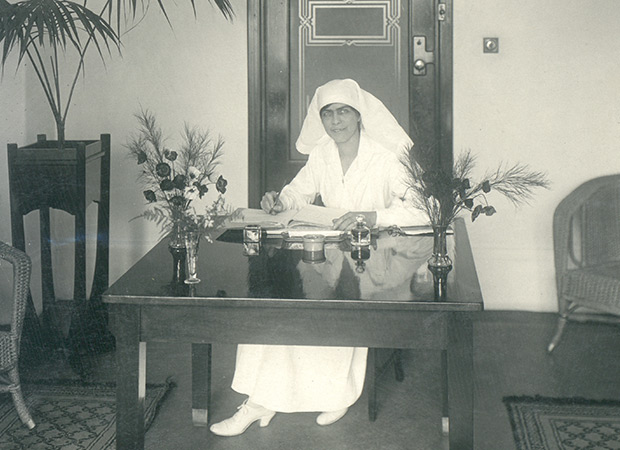
Portrait of Nurse Elizabeth Murrell, 1919
Douglas Kitto
Douglas Kitto was born in Lefroy, Tasmania in 1895. His ancestors were miners for many generations in Cornwall before his father, Thomas Kitto, immigrated to Australia in the 1850s to try his luck on the Victoria goldfields, before eventually moving to Tasmania to work in the mines. Douglas began his military service at the tender age of 16 when he enlisted in the Australian Field Artillery, where after three years he achieved the rank of Corporal and, finally, Lieutenant. Kitto chose a markedly different career path to that of his father and grandfather and in 1914 entered the employment of the Hobart Branch of the Commonwealth Bank as a clerk. By 1915 he had transferred to the Launceston branch of the bank and in September of that same year he enlisted in the 6th Field Artillery Brigade. Entering service with his previous military experience, he was immediately awarded the rank of 2nd Lieutenant and quickly promoted to Lieutenant by the time his unit had reached France. By March 1917 he was serving with the 11th Field Artillery brigade, remaining with this unit until the end of the war. Kitto’s service is recorded as both distinguished and eventful and it eventually saw him rise to the rank of Major with no less than five wounded stripes.
April 1917 saw Kitto chase the retreating German forces to the Hindenburg line. His conduct earned him a mention in the dispatches of Field Marshal Sir Douglas Haig for his actions while his unit operated under enfilade machine gun fire. The battle had disrupted the allies’ communication line, so under heavy shell and rifle fire Douglas relayed the information himself. Despite being wounded he remained at his post with his men until he was ordered to stand down to receive medical treatment. By the end of April he had been more seriously wounded and was evacuated to England to recover from his multiple injuries. However, displaying the determination and strength he was so often commended for, Kitto returned to his unit within less than a month, which was now in position for the battle of Messines on 7 June 1917. In September his unit was deployed to Bailleau, where under heavy bombing he was injured for a third time, suffering a shrapnel wound to the scalp before being evacuated to England for two months to recover. Once again displaying the formidable nature and strength of character that would later see him earn him a military honour, he returned to his Battalion and spent the European winter in the trenches of Ploegsteert, Belgium.
In April 1918 Kitto was awarded the military Cross for his ’gallantry in action and devotion to duty’. After suffering a serious gunshot wound to the head, he displayed great bravery and determination in single-handedly helping to maintain the position of the Australian battalions. In full daylight, and in order to obtain an advantage over the enemy, he walked to the front line and climbed down a forward slope exposed to enemy fire. From this position he was able to observe the locations of the German machine guns, trench mortars and assess the effectiveness of the fire of his own Battery. After a further two months spent recovering from this wound, he once again returned to the front before being wounded for a fifth time, just a month later. Maintaining the position of his unit on what was described as a relatively quiet day, a shell landed directly on the Battery’s position and Kitto suffered wounds to his right side, head, right hand, leg and arm. After yet another miraculously short period of recovery he was promoted to the Rank of Major and returned to his unit in France.
At the end of the war Douglas returned to Hobart and his position with the Commonwealth Bank for a short period before moving to Victoria. He then married Marian McKay, raised two children and obtained a Bachelor of Commerce degree from the University of Melbourne.
Not one to ever miss an opportunity to serve his country and return to battle, in 1934 Kitto reenlisted in the army, serving first as Lieutenant- Colonel and, by the time WWII had begun, a Colonel. Douglas retired from the Army in March 1945 as Brigadier. After suffering some very serious wounds and injuries during WWI (from which even the most resilient soldiers did not recover) it is astonishing that Douglas not only survived the war, but that he passed away 4 December 1988 at the prodigious age of 92.
John Arthur Chambers
John Chambers' desire to serve was instilled in him from earliest childhood by his father Reverend William Chambers, a Methodist Missionary. The second of four brothers, John was born on the island of New Britain in Papua New Guinea, spending most of his childhood in missions throughout the Pacific Islands. While just one of his brothers chose to continue in their father’s footsteps and enter the church as a missionary, they each learned the value of service from their parents and let it guide their own lives. As the family were originally from Tasmania it was to there that John returned to begin his working life. He was employed in the Hobart branch of the Commonwealth Bank as a clerk from 1914, transferring to the newly opened Launceston branch at the end of the year.
On 12 January 1915 John decided to enlist in the Australian Imperial Force (AIF). In this he followed the example of his elder brother Sergeant Leslie Chambers who had enlisted when war was declared. The brothers had the good fortune to serve in the same Battalion, under the command of John’s friend and colleague from the Commonwealth Bank, Lieutenant-Colonel Ernest Hilmer Smith. John joined the Battalion at Gallipoli a month after the landings and remained on the peninsula until the evacuation in December. When he reached France in April 1916, it was without his brother who had suffered greatly from illness whilst at Gallipoli and had remained behind in an Egyptian hospital. The two brothers were never to fight together again; Leslie lost his life in Belgium in November 1917, aged just 24.
The first major action John saw on the Western Front was at Pozières in July 1916. Less than a month later he was with his unit near Mouquet Farm when he was shot in the shoulder. He was evacuated to England and did not return to the front line again. When he returned to duty he was attached to the Headquarters of the AIF Depots in the UK. In January 1917 he was detached for duty with the Commonwealth Bank in London, where he remained until June 1919.
When John received his discharge in October 1919 he only briefly returned to Australia. He went back to work for the Commonwealth Bank but soon chose to transfer to the Rabaul branch, returning to the country of his childhood. Eventually he returned to Hobart in 1922 and married fellow Commonwealth Bank staff member Kathleen Lyall Street in 1929. They later moved to NSW where he worked for the Commonwealth Bank at Cremorne Junction until his retirement.
William Hermann Thummler
William Thummler was born in Hobart, Tasmania in 1887. After finishing school he joined the State Savings Bank where he worked until in 1913 he applied, and was accepted, for a job in the new Commonwealth Bank branch in Hobart. William enlisted in the Australian Imperial Force on 12 October 1916 when he was 29 years old. He embarked from Melbourne in November 1917, arriving in France in April 1918 and joining the 3rd Australian Field Artillery Brigade in the field in France.
William was involved in fighting in the Somme Valley throughout the summer of 1918. His Battalion moved into the vicinity of Péronne on the River Somme at the beginning of September. On the evening of 3 September, William and his close friend Gunner Ralph French were sheltering in an old German trench discussing whether to turn in for the night when a shell landed at their feet. William was badly wounded by the blast but managed to crawl to safety through a choking cloud of gas. His friend Ralph was more grievously injured and died almost instantly.
The severity of William’s injuries kept him in hospital for over two months. He was never able to return to fight with his unit. Instead, he was attached for duty with the Commonwealth Bank in London, where he remained until July 1919 when he returned to Australia.
Back in Tasmania, William resumed work at the Hobart branch and, with a transfer to the Adelaide branch in 1936, continued working for the Commonwealth Bank for the rest of his career. A year after returning to Hobart William married an Irish girl, Alice Wright. The wedding was celebrated in St. John the Baptist’s Church where William had served as a churchwarden since 1912. His friend, colleague and fellow veteran John ‘Jack’ Neighbour stood up with him as groomsman.
Cyril David McIntyre
Born in Gosford, NSW to banker William McIntyre and his wife Isabella, Cyril McIntyre was a 20 year old bank clerk working in the Commonwealth Bank’s Hobart branch when he joined the war effort. As he was under the age of 21, Cyril’s father was required to provide written permission for his son to join the Australian Imperial Force. Cyril, who, like many of his fellow Tasmanians had prior Military experience having already spent 3 years as a Senior Military cadet, enlisted in the war in June 1915 with his father’s blessing.
By October 1915 Cyril had joined the 1st Australian Casualty Clearing Station. In October 1914 a new type of medical unit had been added to the Australian Army’s evacuation procedure. Originally named the ‘Casualty Clearing Hospital’, it was first referred to as a ‘Casualty Clearing Station’ on the beach at Anzac Cove during the Gallipoli campaign. This unit was established as the forward-most unit available to provide emergency surgery on the battlefield. In this position it freed front line field ambulances from having to hold wounded soldiers prior to treatment, thereby improving their own safety, mobility and allowing them to move with the brigades they supported. The Casualty Clearing Station was described as the most medically advanced unit of its time, where specialist surgeons, anaesthetists, nurses, radiologists and even a dentist were to be found. Cyril McIntyre’s unit, the 1st Australian Casualty Clearing Station (1ACCS), was raised in Hobart and consisted initially of 93 men, including 7 Doctors. After seven weeks of training the new unit embarked for Egypt and the Gallipoli offensive. They landed on the beach at Anzac Cove at 11 am on 25 April 1915 and remained on a 20 metre stretch of the beach throughout the eight months of the Gallipoli campaign. During this time the (essentially inexperienced) medical unit treated and evacuated an estimated 2700 wounded Australian and New Zealand soldiers.
After suffering sickness and minor injures throughout the war, often needing treatment from his very own unit, McIntyre was discharged due to ill health in June 1919. By this time his parents had moved to Queensland and his father was now a senior manager with the Commercial Bank. Cyril initially resumed duties with the Commonwealth Bank, however by the early 1920s he had entered into business with his father, founding the Australian Novelty Advertising Company. In September 1927 Cyril married Elsie Roberts at St John’s Cathedral Brisbane in what was described as one of the ‘society’ weddings of the year. An Article in theQueensland Figaro, 24 September 1927, provides detailed descriptions of the wedding party and the extravagant event. Sadly Cyril passed away in 1935 at the relatively young age of 40.
Battle Profiles
Centenary of the First Battle of Bullecourt, 11 April 1917
The Hindenburg Line was Germany’s strongest defence on the Western Front, with trenches stretching from Arras to Laffaux in northern France. Incorporated into this line were several villages, strongly fortified by Germany, including the village of Bullecourt. On 11 April 1917 Bullecourt was attacked by the 4th Australian and 62nd British Divisions. Although the infantry managed to break into the German defences, the Australians were forced to retreat. They suffered 3,300 casualties and 1,170 Australians taken prisoner, the ‘largest number captured in a single engagement during the war’.
Lieutenant D.O.L. Kitto was mentioned in despatches for his bravery and fortitude during the attack of the First Battle of Bullecourt.
The Battle of the Somme

The Women's Committee of the NSW Second Peace Loan Campaign held a rally in Moore Street (now Martin Place) during August 1920, focusing on those who had served at the Somme. Some women are wearing badges, indicating that their sons or husbands had seen active service. The huts in the background formed part of ‘Diggerville’, a place which helped returned servicemen find an apprenticeship and occupation, as many had missed this stage of their education and training by serving in the war.
The Battle of the Somme, or Somme Offensive, took place between July and November 1916. This year the nation commemorates the centenary of events at the Somme that are described by the head of the Australian War Memorial, Dr Brendan Nelson, as 'beyond the comprehension of our comfortable modern lives'. There were 39 Commonwealth Bank staff members who fought and served during the Somme Offensive. Three of these died and their bodies rest near the villages of Fromelles and Flers. Of the 36 Bank staff who survived, nine were wounded. Most of these wounded men were unable to ever return to the front. The remainder endured two more years of fighting before they could return home.
On 19–20 July 1916 at Fromelles, there were over 5,500 Australian casualties in 24 hours. One of the Australians who lost their lives in this attack was Commonwealth Bank officer Major Roy Harrison. A veteran of Gallipoli, he was the only original officer of the 2nd Battalion to remain at Gallipoli from the April landing until the evacuation in December. Transferred to the 4th Battalion in early 1916, he was reported missing after the attack at Fromelles and assumed killed in action. Five years later the remains of an officer were found with a small silver cigarette case inscribed with his name in the uniform pocket.
The endurance and determination of the Australian soldiers during the Somme Offensive is exemplified in men like Captain Francis Claude Lloyd who fought at Pozières where there were 23,000 Australian casualties in six weeks. A clerk at the Commonwealth Bank in Brisbane in civilian life, he was awarded the Distinguished Conduct Medal for his actions at Pozières where, despite being injured in both legs and sustaining a head wound, he remained on duty to organise the withdrawal of his men before allowing himself to receive medical attention. Sergeant John Somer from the Bank's Melbourne Office also elected to remain on duty after being wounded shortly before the initial attack at Pozières, choosing to remain with his mates and fight by their side. Others from the Bank's staff were more severely wounded in the fighting at Pozières. Both Private Roland Jackson and Signaller John Chambers suffered wounds that would prevent them from returning to the front line for the remainder of the war.
The wounds suffered by the men were not only physical. Cases of shell shock were common because of the terrifying conditions under which the troops lived and fought at the Somme. While some men would never recover from the experience, others were helped by time away from the front lines and were eventually able to return to their units. The experience of Corporal Bruce MacFarlane of the Bank's Lismore Branch was not unusual. Wounded at Pozières in August, he was diagnosed with shell shock after his unit was withdrawn from the front lines. After a period of recovery he returned to his battalion and was with them when they attacked the notorious 'Maze' defence system near Flers in early November. He was badly wounded in the back and shoulder during the attack and was later transferred to the Army Pay Corps spending the remainder of the war in London.
The final cold November weeks proved the most costly for the Bank's enlisted staff. Private Ian McLachlan, one of three staff to enlist from the Bank's branch in Orange, was killed in action near Flers on 15 November barely a month after joining his battalion. Private Harry Pillinger died of wounds he received while acting as a stretcher bearer with the 6th Field Ambulance on 7 November. He was dressing an injured soldier's wounds in a dugout when a shell exploded next to them badly injuring Pillinger who died shortly after reaching the nearby casualty clearing station. Private Harold Wright suffered badly from shell shock and in mid-November was evacuated from the line experiencing a loss of memory. Wright recovered and returned to the front lines towards the end of November. On Boxing Day 1916 he was admitted to hospital, suffering both a spinal concussion and shell shock once more. He remained in England for some months before being sent home to Australia with a medical discharge. Both Corporal Bruce MacFarlane and Sergeant Raymond Watts were severely wounded. While MacFarlane recovered from his wound and served away from the front line for the remainder of the war, Sergeant Watts was discharged as being medically unfit after spending eight months in hospital in England.
It was winter and not victory that ended one of the bloodiest battles of the war. After the horrors of the 141 days of the Somme Offensive, the men now settled into their mud-filled trenches preparing to endure what was to be the coldest winter of the war.
Branch Profiles
Profile of Hobart Branch
Hobart's Heroes[1]
At the height of hostilities during World War I, just over half the staff from the Commonwealth Bank of Australia’s (CBA) Hobart Branch[2] had enlisted. As the Reserve Bank descended from the central banking division of the Commonwealth Bank, we honour the staff from the Hobart Branch and share their story.
The Bank was barely two years old when World War I was declared. For Governor Denison Miller, this international calamity posed two very immediate professional challenges, as well as an incalculable personal crisis. On the business front, the Governor was well aware that the war heralded a potential economic crisis and an important central banking role for the newly formed institution; at the same time, he saw that there was an urgent need to keep the Bank’s administrative offices and branch network operational in the face of the mass departure of male employees who were eager to defend the nation.
On this latter issue at least, Governor Miller was able to act quickly and decisively. As well as formalising the Bank’s procedures for military leave, he broke with tradition and temporarily replaced his male bank officers with female staff.
On the home front, he did not manage the shock of the war so well: three of his four sons enlisted, only two returned.
The impact of the war was felt in homes country-wide and in the Bank’s branches across all locations. It was particularly striking in Hobart, Tasmania, where the population was relatively small and the passionate expressions of loyalty to the British Empire were overwhelmingly large. Around 35 per cent of the male population of Tasmania enlisted in World War I – some two-thirds signing up in the first two years. More than half of the 13 000 who served overseas were casualties, with 2 432 losing their lives.
Some 14 of the 22 staff at the CBA’s Hobart branch took part in the war effort. Two of these brave young men (Edwin Clifford Trethewey and Vivian Cyril Brooke) were killed in action while fighting in Harbonnieres, Somme in France and Gallipoli respectively.
The news of Brooke’s death reached the branch in early May 1915, not long before clerk Cyril McIntyre joined the 1st Australian Casualty Clearing Station at Gallipoli. Others were already overseas, including Rupert Pennycuick, who was fighting in Egypt with the 3rd Light Horse Regiment, and John Chambers, who was serving in the 12th Battalion under the command of the branch’s superintendent Ernest Hilmer Smith. Five more bank staff enlisted in 1915 and another two enlisted in 1916 when Australia joined the fighting along the Western Front. Although they served in different battalions and in different spheres of the war, they tried to keep in touch with each other and the staff back in Australia, and to maintain the ties that had been formed in the close-knit Hobart branch.
It took almost two years for the final staff member, Victor Tolland, to return to Australia and receive his discharge after the armistice was declared in November 1918.
Many lives were dramatically changed by the war. Bank employees Thomas McGhee and Victor Tolland both returned to Tasmania as married men ready to settle down with new families. Ernest Hilmer Smith came back a decorated hero after being mentioned in Sir Douglas Haig’s despatches; he was subsequently appointed a Companion of the Order of Bath. Others were happy just to pick up the lives they had left behind and enjoy simple pleasures like re-joining the Bank’s cricket team.
Every one of the men who returned from the war was welcomed back to their positions at the Bank. Many went on to have long and successful careers and a few, like John Chambers, enjoyed some unexpected surprises. Showing that happy endings can appear in even the darkest moments, John went on to marry Kathleen Street, the young woman who had been hired to replace him when he went to war.
Please email us if you are a relative or have further information that you would like to share.
